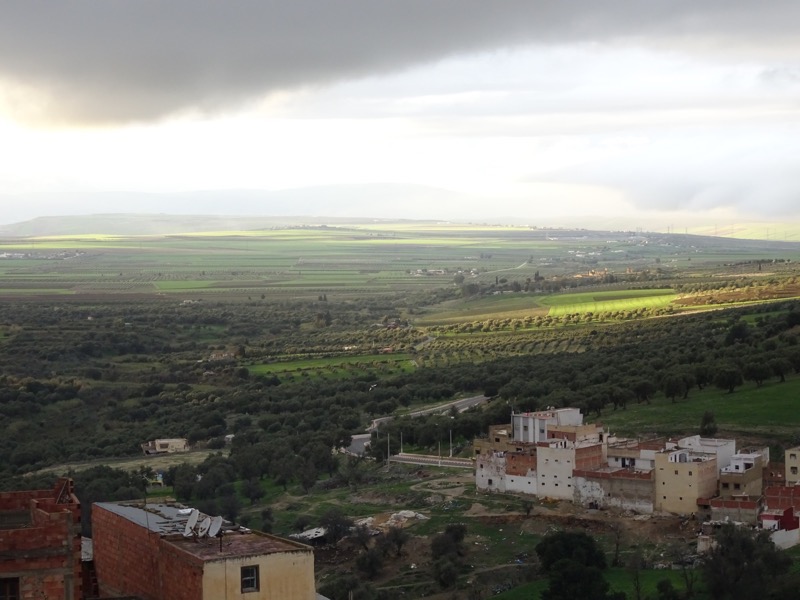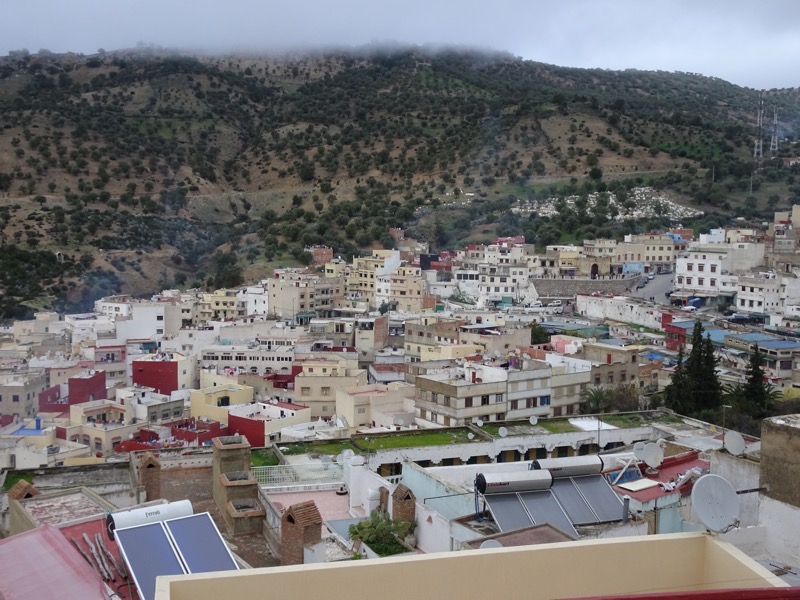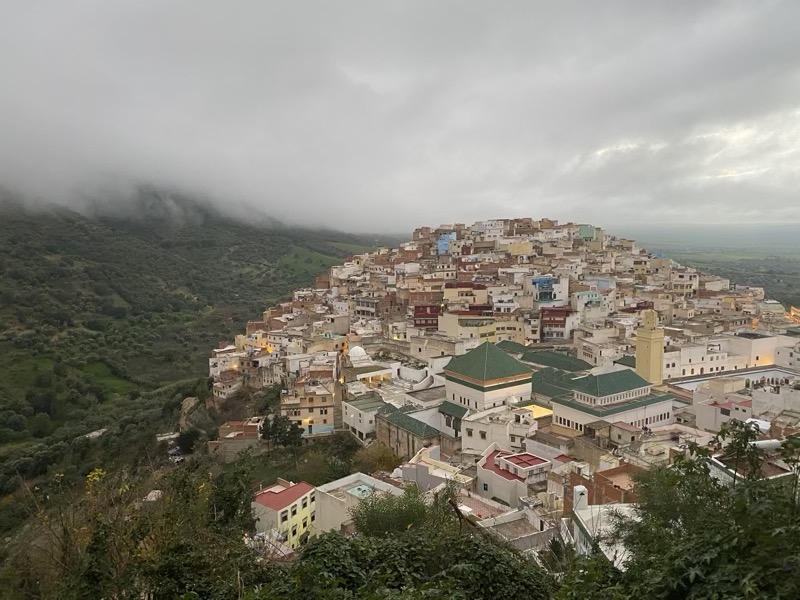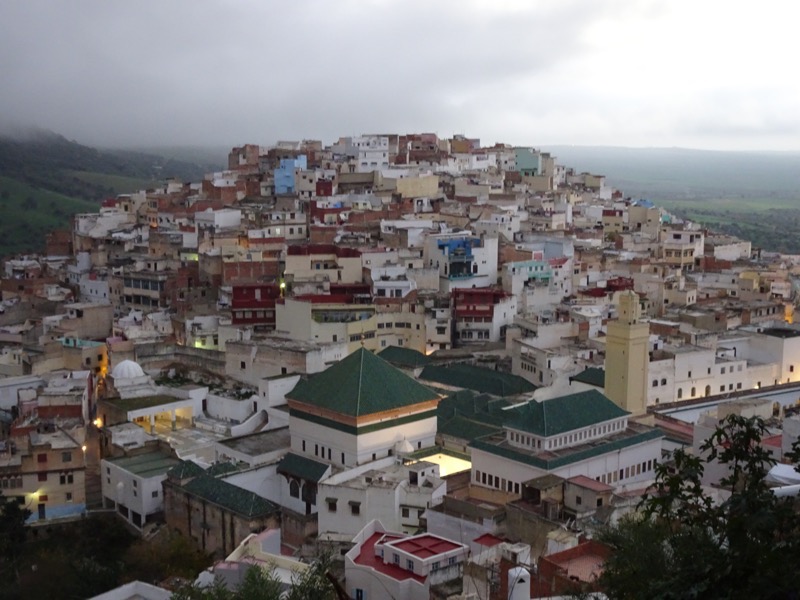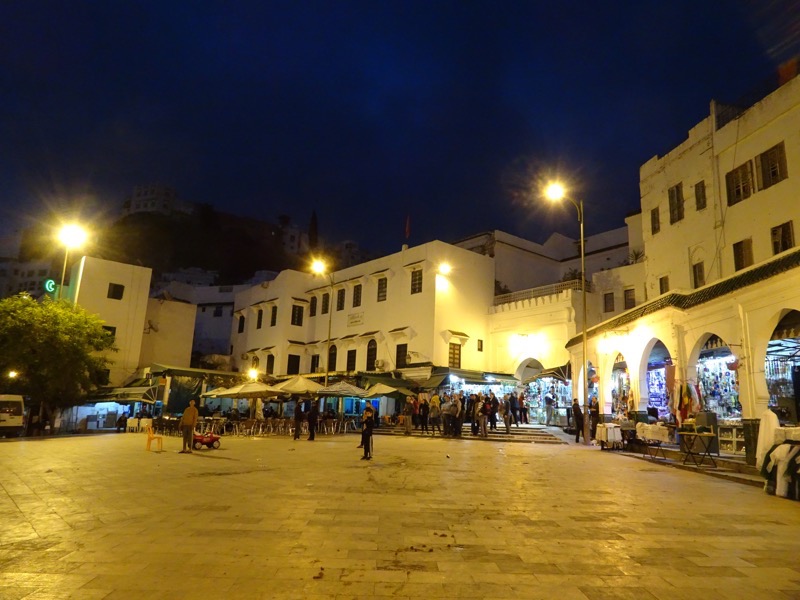If you’re over the crazy blue walls and doors of Chefchaouen, then I suggest you close this now and come back tomorrow… this place has me entranced and this post is all: blue, blue, and bluer! 🙂
We had a free day today to potter around this gorgeous little town and decided we would have a lazy start to the day today. Attempted to sleep in – unsuccessfully which is no real surprise (my back is just not happy, especially seeing I’ve had to leave some medications at home) and we eventually went out to the terrace restaurant for breakfast around 9ish.
This is the view that greeted us from the terrace restaurant at the hotel over breakfast. Our room is the bottom one here – we were given the top floor, but gave it to Tess and Karl when I decided I didn’t really feel like walking up six flights of stairs every time we came and went from our room.
Our room is the bottom one here – we were given the top floor, but gave it to Tess and Karl when I decided I didn’t really feel like walking up six flights of stairs every time we came and went from our room. After breakfast, we ran into Jake and Tyson, who were chilling out using the wifi in a little fabric lined antechamber off the hotel lobby. They’re from California, both in college and travelling with their lovely grandparents, Chris and Allan. They’re really nice guys, though sometimes listening to how they talk to each other makes me laugh. They’re sure making themselves comfortable…
After breakfast, we ran into Jake and Tyson, who were chilling out using the wifi in a little fabric lined antechamber off the hotel lobby. They’re from California, both in college and travelling with their lovely grandparents, Chris and Allan. They’re really nice guys, though sometimes listening to how they talk to each other makes me laugh. They’re sure making themselves comfortable… 
 Christian may be the only person we beat to breakfast, he’s from Quebec, and here he is looking out over the view from the terrace restaurant.
Christian may be the only person we beat to breakfast, he’s from Quebec, and here he is looking out over the view from the terrace restaurant.
Anyway, there were only a few things on the very loose agenda today: 1) Get my phone to a Maroc Telecom and figure out why my SIM card is only ever getting 3G reception, 2) potter around the medina and have a good poke around the handicraft shops, 3) check out the Kasbah this afternoon and 4) buy a djouba (or two)
So we set off trying a different way to get around town through some less touristy worn streets to find the Maroc Telecom. It was a 15 min walk or so and mostly downhill. I have to say, Morocco needs to smarten its act up a bit on their stairs – we haven’t really seen a flight of stairs that are ‘regular height’ so it’s quite hard on the knees and ankles when going downhill, especially if you miscalculate the height of the step.
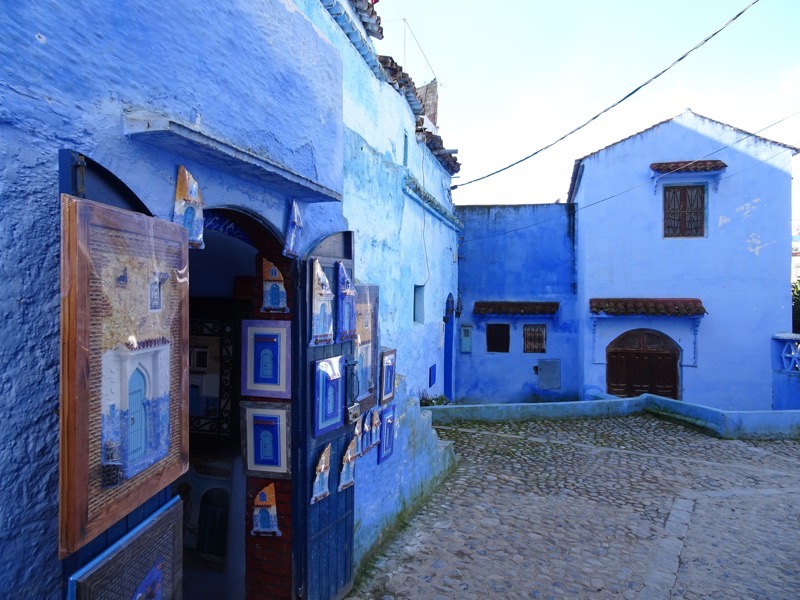 On our way to the telco, we wandered through some more residential type areas, which were just as blue as the main touristy streets.
On our way to the telco, we wandered through some more residential type areas, which were just as blue as the main touristy streets. We met a lovely lady at the Maroc Telecom who was able to assist me with my 4G problem, in spite of my halting French. She told me that my SIM wasn’t properly activated and promptly fixed it. Service with a smile from a telco – who knew such things even existed? After we left there, we decided to take a taxi around to the top of the springs where we pretty much started yesterday’s walk – it wasn’t much farther than we had just come, but it was all uphill through the very winding streets, and today was supposed to be a chill day – so we shelled out the exorbitant AUD$3 for a Petit Taxi. Got to the top and there were men selling photos with their birds… I managed to sneak a picture of the guy’s peacock – but the guy standing beside an ostrich taller than he was, eluded me.
We met a lovely lady at the Maroc Telecom who was able to assist me with my 4G problem, in spite of my halting French. She told me that my SIM wasn’t properly activated and promptly fixed it. Service with a smile from a telco – who knew such things even existed? After we left there, we decided to take a taxi around to the top of the springs where we pretty much started yesterday’s walk – it wasn’t much farther than we had just come, but it was all uphill through the very winding streets, and today was supposed to be a chill day – so we shelled out the exorbitant AUD$3 for a Petit Taxi. Got to the top and there were men selling photos with their birds… I managed to sneak a picture of the guy’s peacock – but the guy standing beside an ostrich taller than he was, eluded me.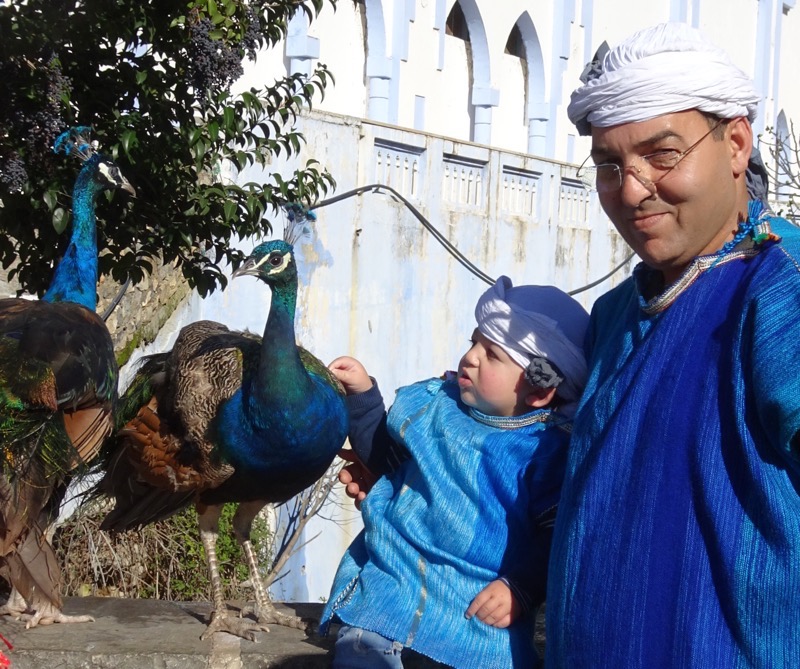 And so we wandered through the narrow pedestrian walkways of the medina checking out the wares lining the streets… so many beautiful handmade things, so many beautiful blue alleys and so many very fancy doorways.
And so we wandered through the narrow pedestrian walkways of the medina checking out the wares lining the streets… so many beautiful handmade things, so many beautiful blue alleys and so many very fancy doorways.
 If felt like there were fewer people around this morning than yesterday evening – not sure if that was the case or if it was because we were trying to wander through the backstreets a bit more, but every time we stumbled back onto the main thoroughfares, it was not particularly crowded.
If felt like there were fewer people around this morning than yesterday evening – not sure if that was the case or if it was because we were trying to wander through the backstreets a bit more, but every time we stumbled back onto the main thoroughfares, it was not particularly crowded.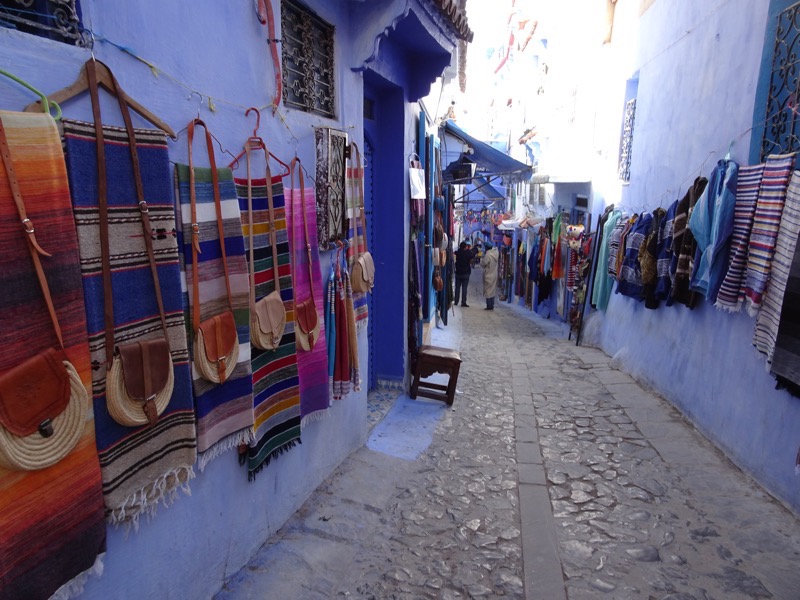


 Very fancy and intricate painting on these doors… my image shrinker has lost a lot of the detail, unfortunately.
Very fancy and intricate painting on these doors… my image shrinker has lost a lot of the detail, unfortunately. 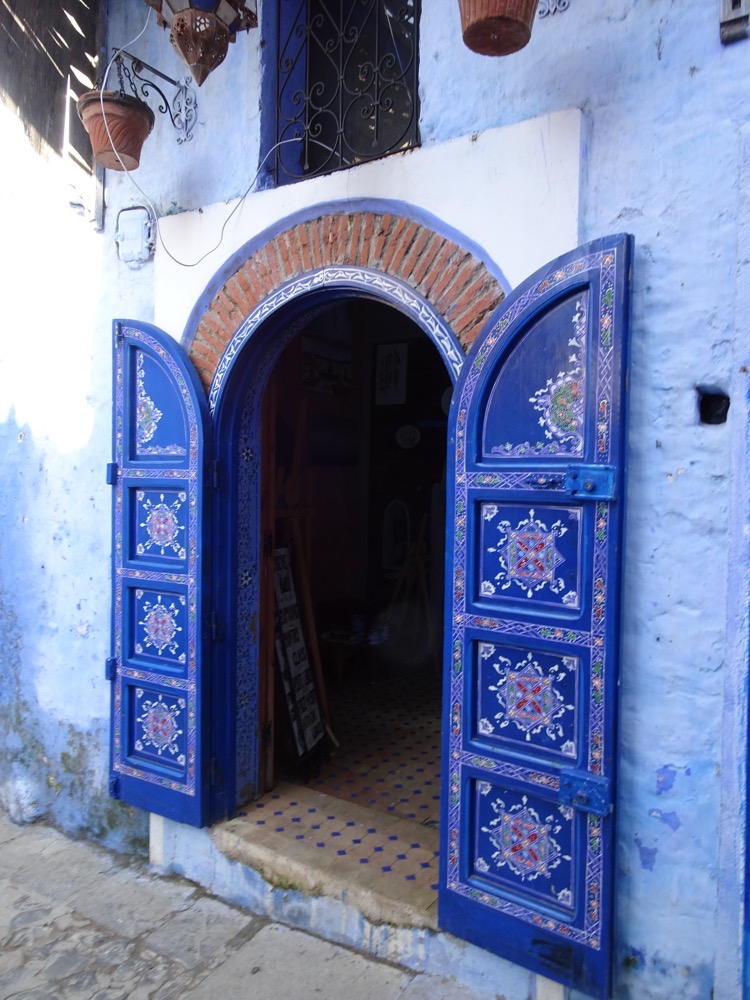 Souvenir hand-embroidered cloths.
Souvenir hand-embroidered cloths.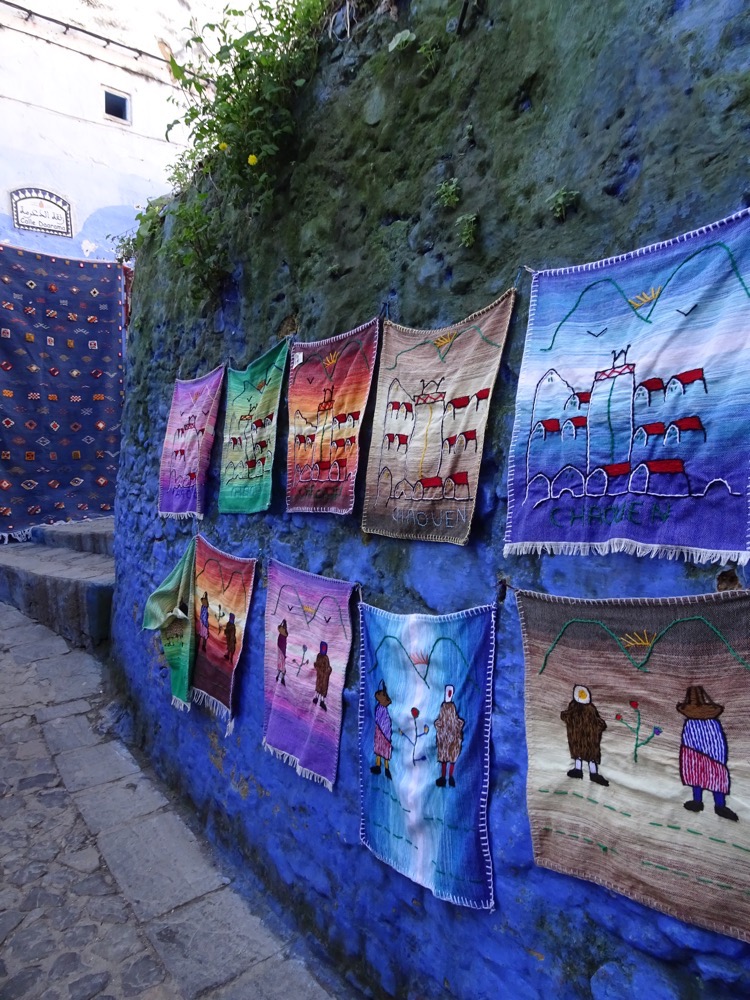 Me – standing in a very short, very blue, doorway.
Me – standing in a very short, very blue, doorway.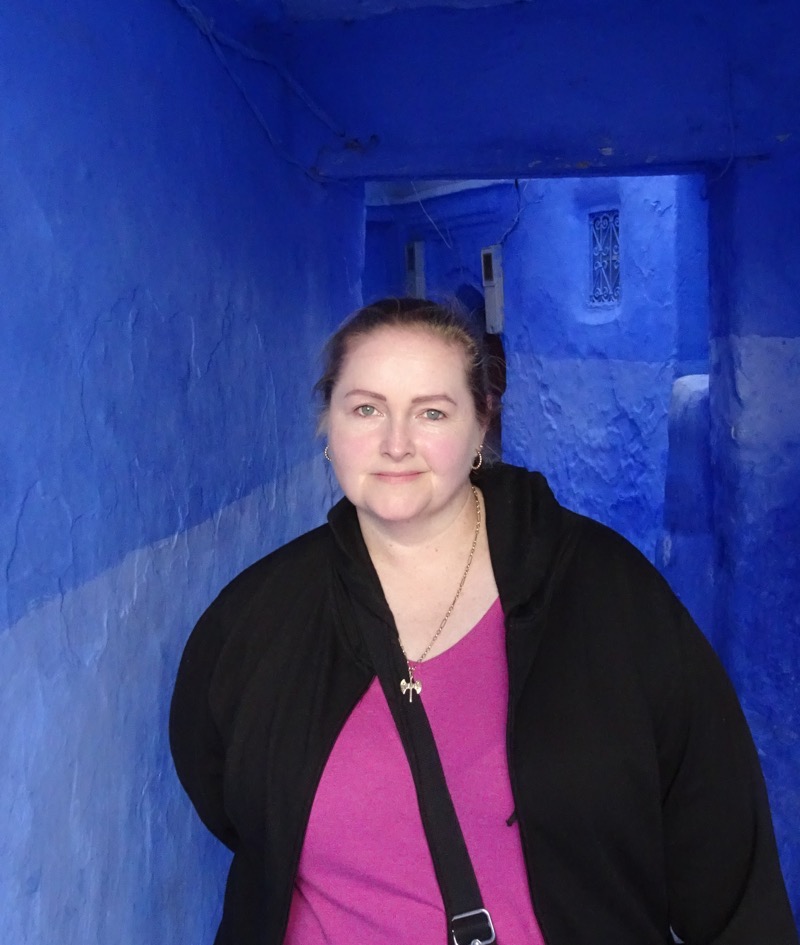
 There were so many very funky hand-knitted beanies everywhere, and I had to stop myself from buying some – but, I think I’ve finally learned my lesson. That lesson being – *You live in Brisbane and it’s rarely cold, you do not need twenty bloody woollen beanies collected from every weird place you go to!*. Well, at least the lesson seems to have held up for today, we will see if it makes it intact through the entire trip.
There were so many very funky hand-knitted beanies everywhere, and I had to stop myself from buying some – but, I think I’ve finally learned my lesson. That lesson being – *You live in Brisbane and it’s rarely cold, you do not need twenty bloody woollen beanies collected from every weird place you go to!*. Well, at least the lesson seems to have held up for today, we will see if it makes it intact through the entire trip.
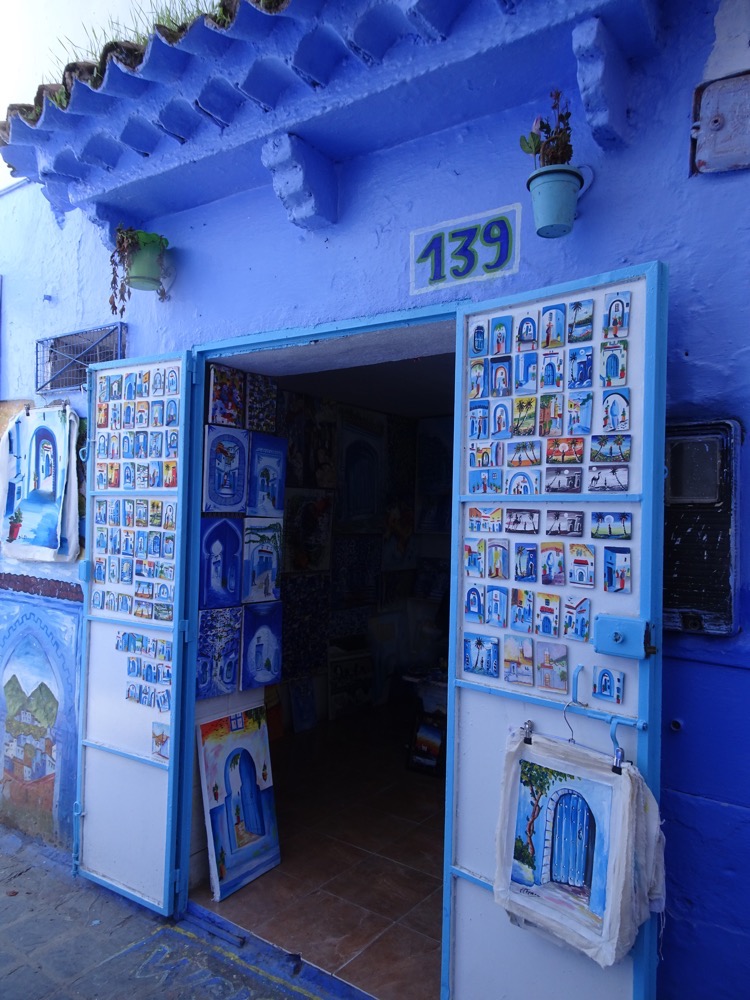 This fountain is fed from the beautiful fresh and clean spring that we went to yesterday, though I have no idea what they have been washing here to make it look so unappealing. Don’t care how clean the water is supposed to be, there’s no way I would fill my bottle from this fountain!
This fountain is fed from the beautiful fresh and clean spring that we went to yesterday, though I have no idea what they have been washing here to make it look so unappealing. Don’t care how clean the water is supposed to be, there’s no way I would fill my bottle from this fountain!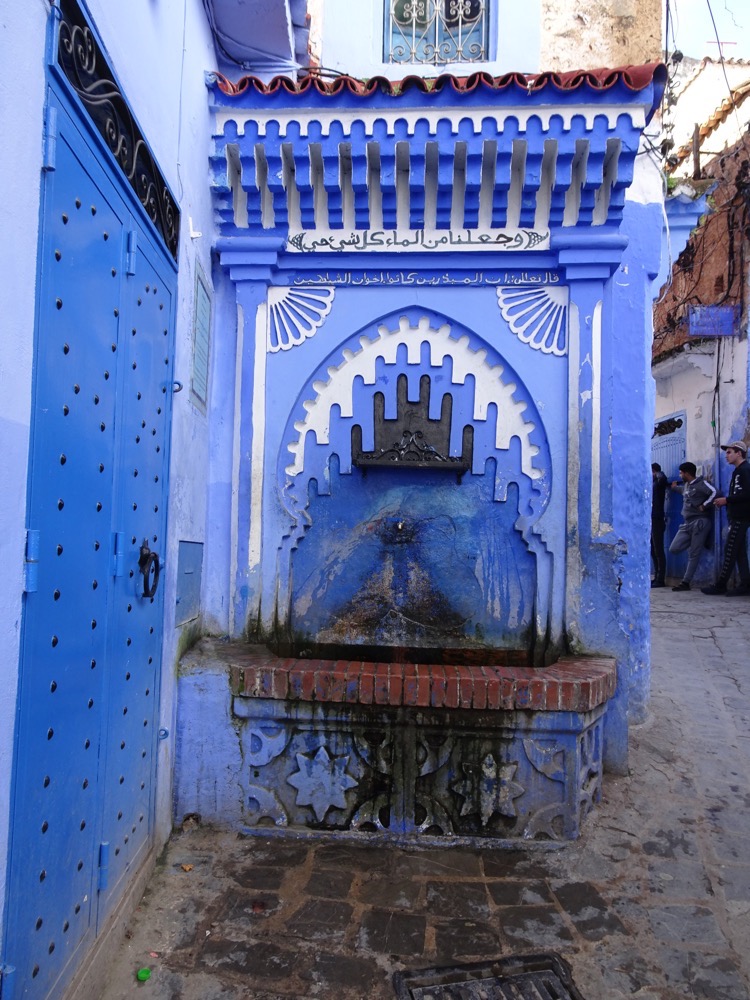
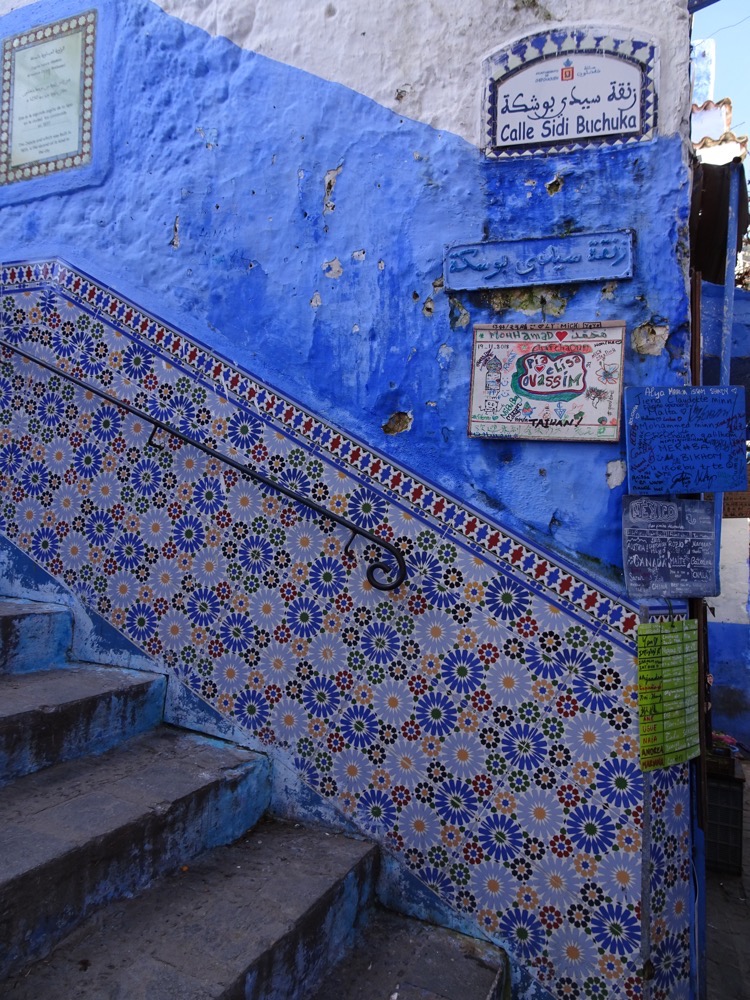 Gorgeous altogether!
Gorgeous altogether!
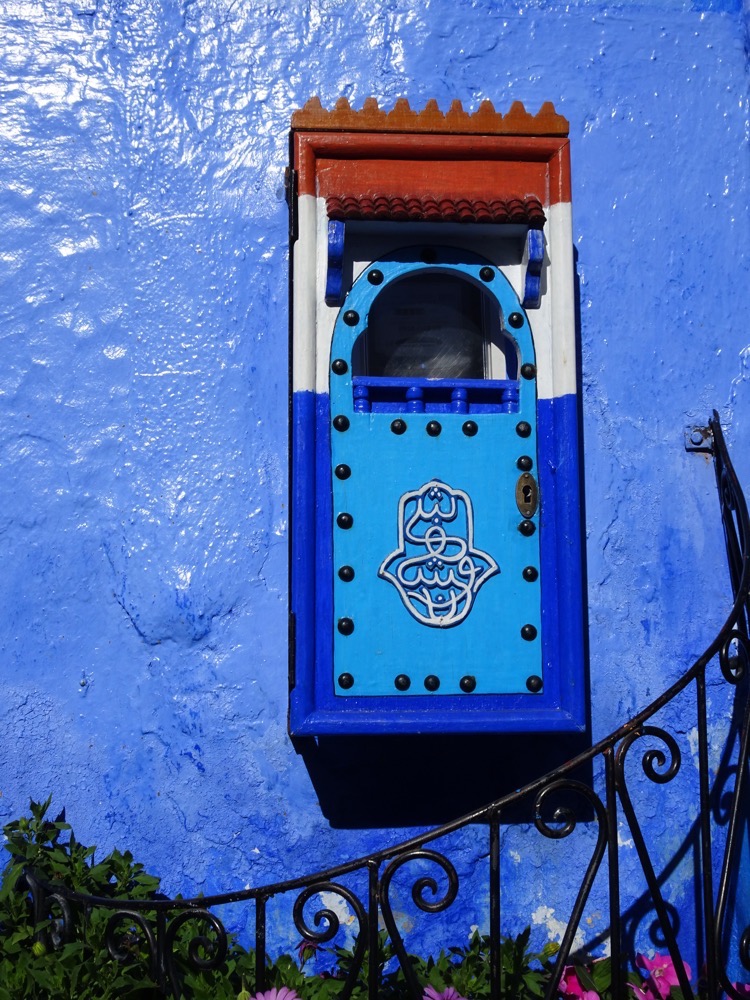

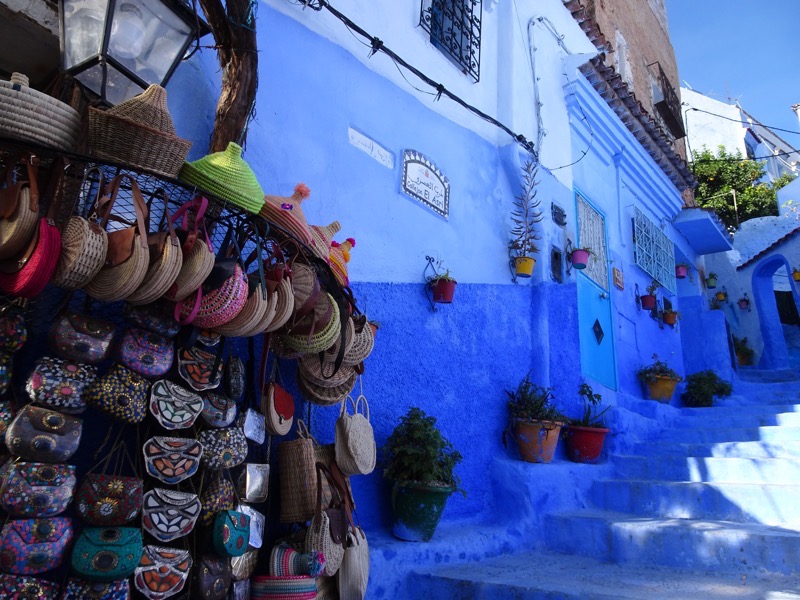 In the back streets looking for interesting alleys and vistas and spied this very steep set of stairs… did a double-take and noticed this little guy:
In the back streets looking for interesting alleys and vistas and spied this very steep set of stairs… did a double-take and noticed this little guy: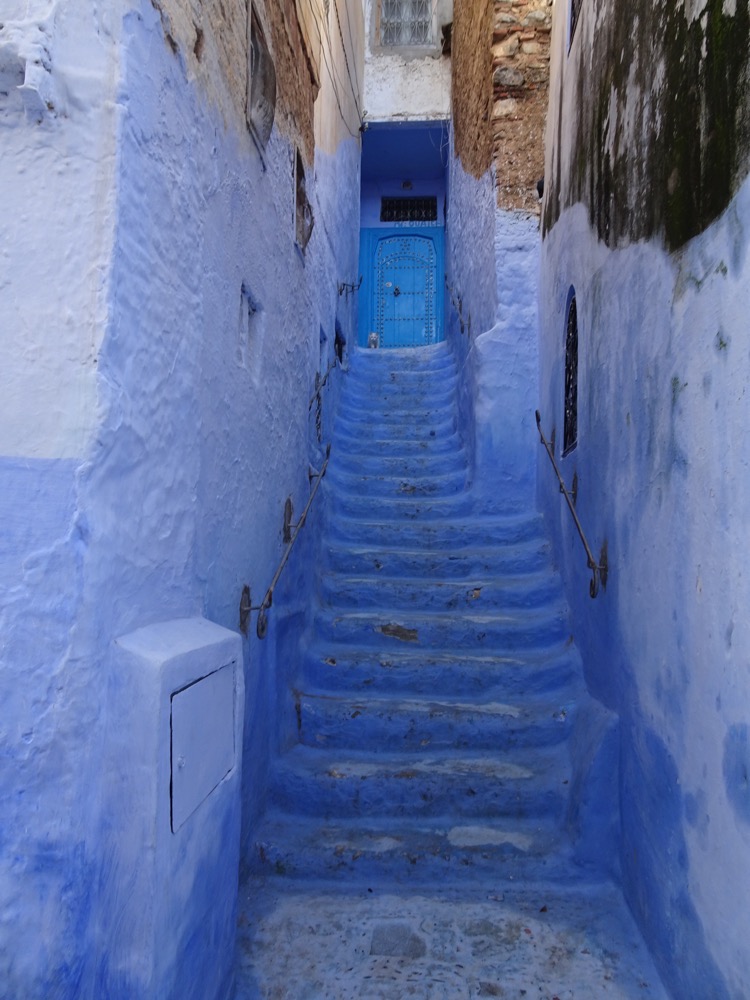 Sitting around like he owned the place.
Sitting around like he owned the place.

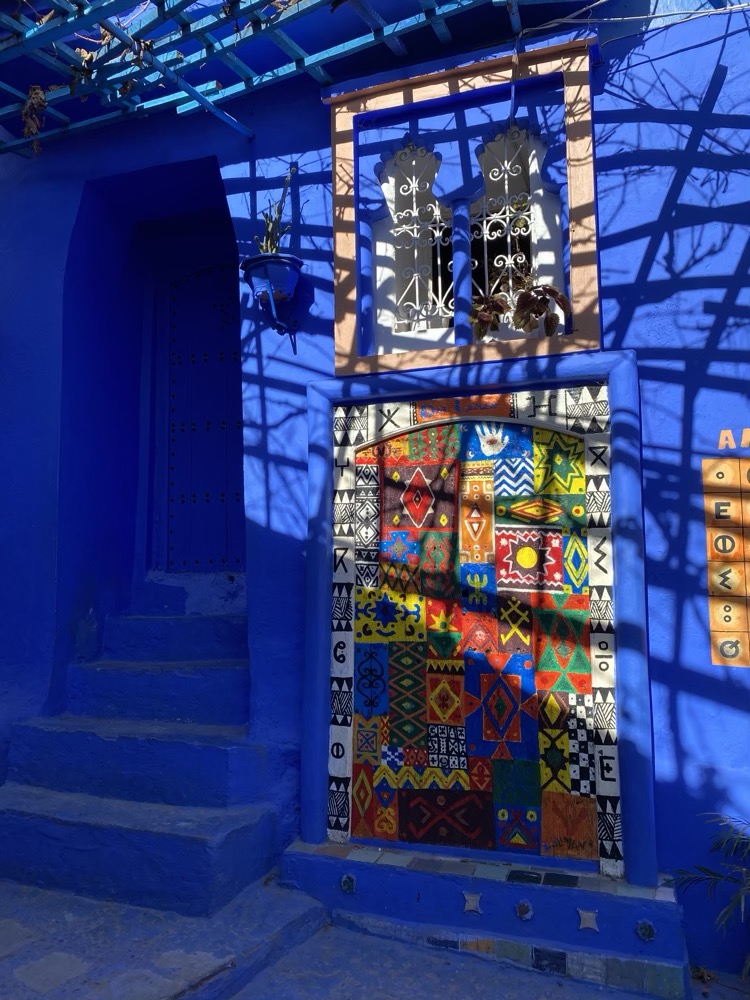 We stopped for lunch down in the main square. Coffee thick as mud, chicken shish, and kofka tagine. Doesn’t take long to decide you could sure get used to this – a long black, a lemon soft drink, two lovingly cooked and very tasty main meals served with free bread, and we were up for a hefty AUD$15.00.
We stopped for lunch down in the main square. Coffee thick as mud, chicken shish, and kofka tagine. Doesn’t take long to decide you could sure get used to this – a long black, a lemon soft drink, two lovingly cooked and very tasty main meals served with free bread, and we were up for a hefty AUD$15.00.
After lunch we went for a walk around the Kasbah and heard some the call to prayer happeining, as it does at regulour intervals during the day. In this town, it seems to set the local dogs off. And we heard these two, barking along – from above! Took a momen to spot them and I have no idea how they got up there! 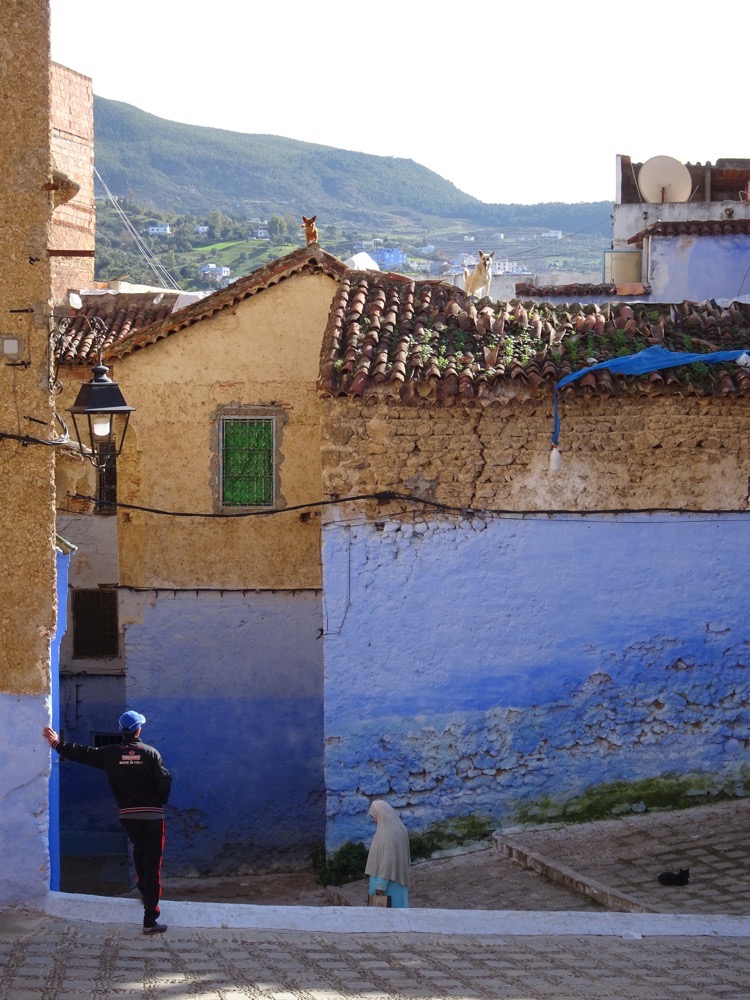

 Gorgeous facade on a local school:
Gorgeous facade on a local school: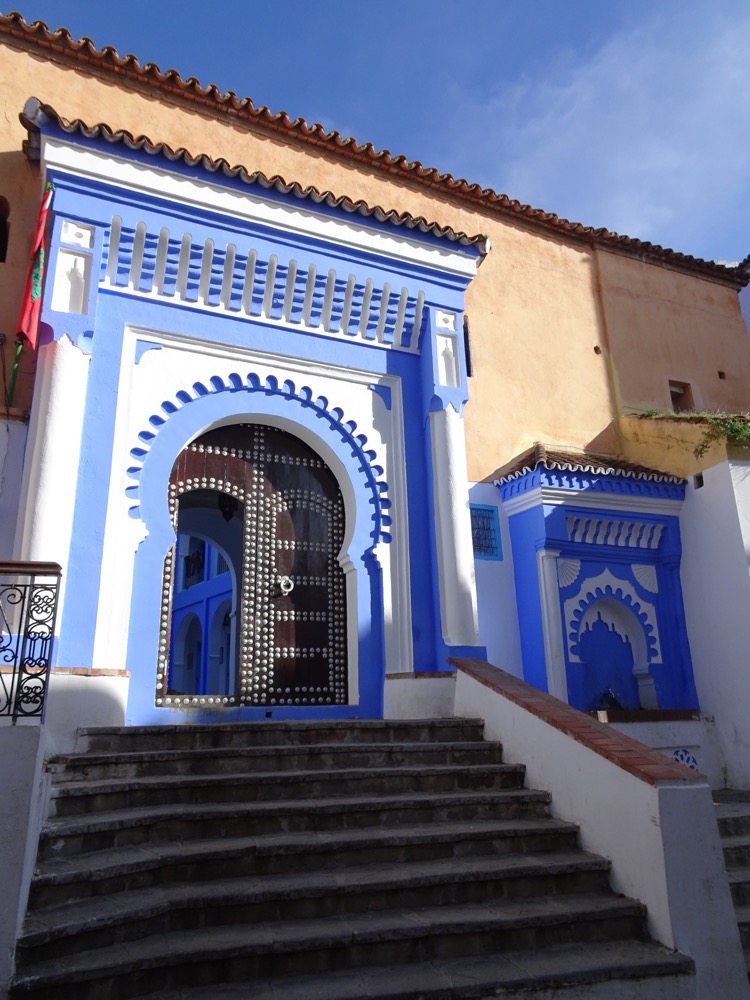 We then made our way into the Kasbah to have a look around. The Kasbah in Chefchaouen was built in the 15thC and in contast to the blue city, it is terracotta-brown in appearance.
We then made our way into the Kasbah to have a look around. The Kasbah in Chefchaouen was built in the 15thC and in contast to the blue city, it is terracotta-brown in appearance. 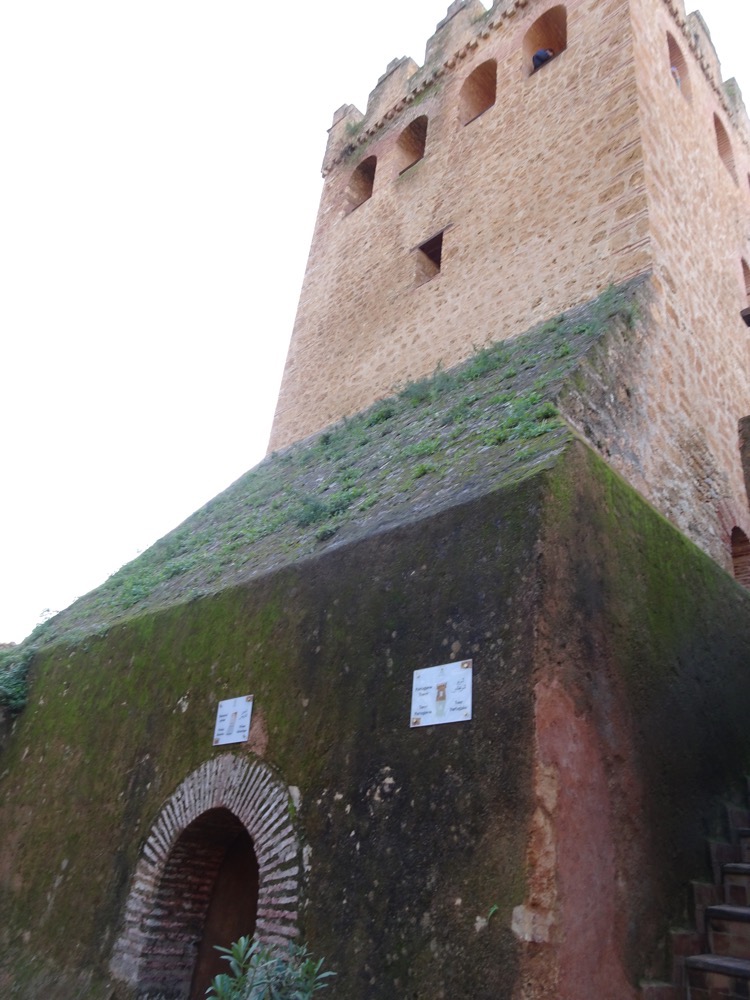
 The Chefchaouen Kasbah contains a lovely Andalusian-style garden and a former prison.
The Chefchaouen Kasbah contains a lovely Andalusian-style garden and a former prison.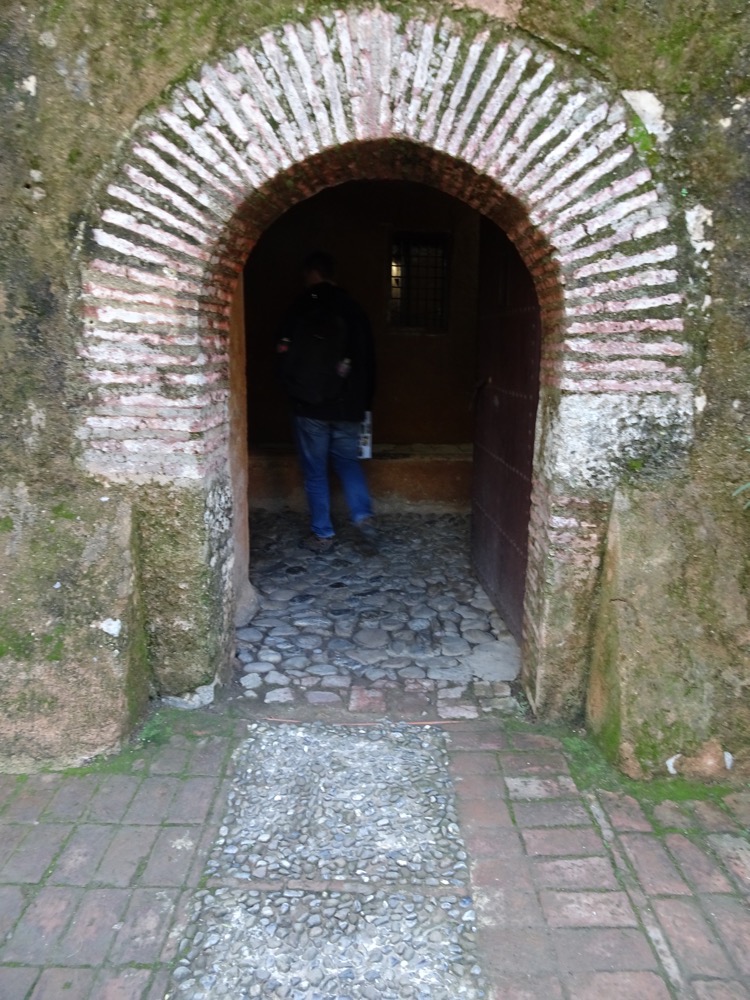 This prision reminds me of the one Kevin Costner finds himself detained in when captured by the Moors while on Crusade in the terribly historically inaccurate, but somewhat lovealbe film, (thanks Alan Rickman) Robin Hood Prince of Thieves (c.1990 something).
This prision reminds me of the one Kevin Costner finds himself detained in when captured by the Moors while on Crusade in the terribly historically inaccurate, but somewhat lovealbe film, (thanks Alan Rickman) Robin Hood Prince of Thieves (c.1990 something).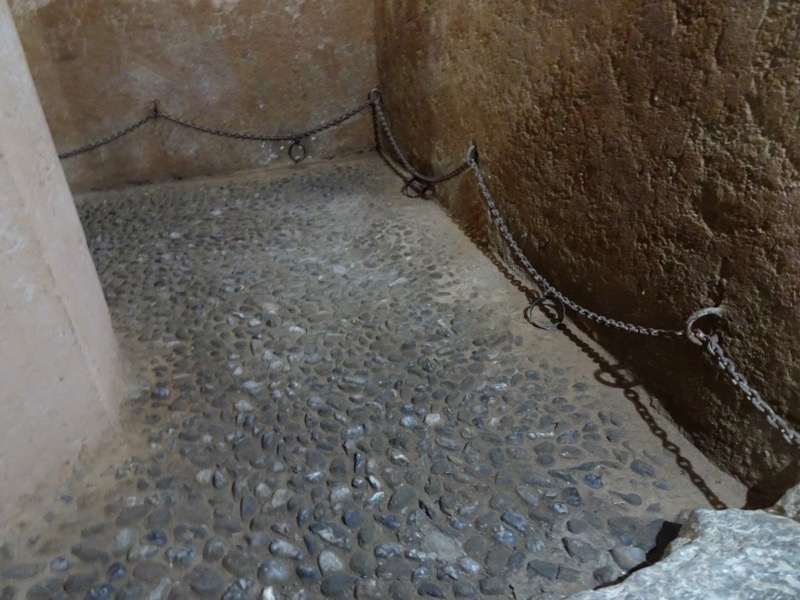
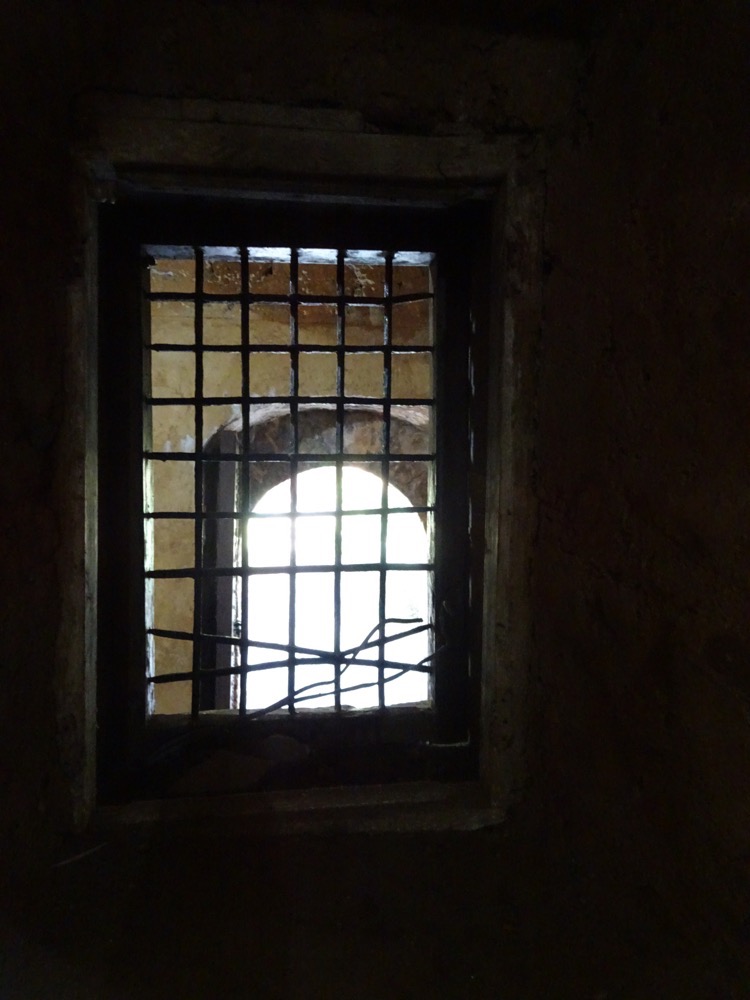

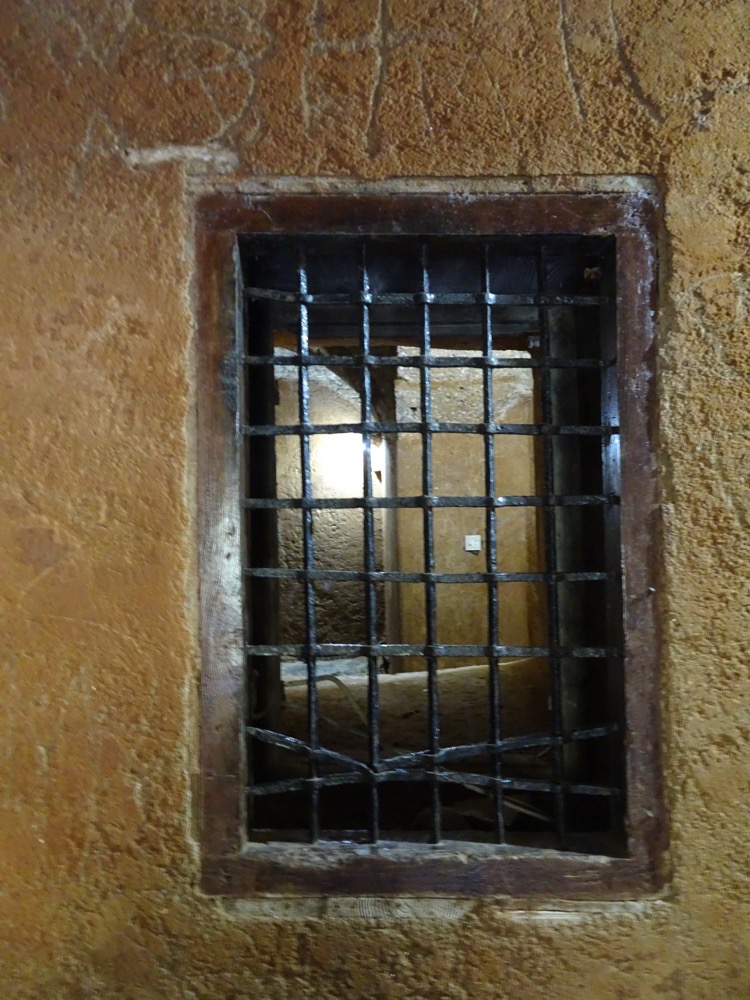 Looking out from the prison to the Andaluscian gardens.
Looking out from the prison to the Andaluscian gardens. 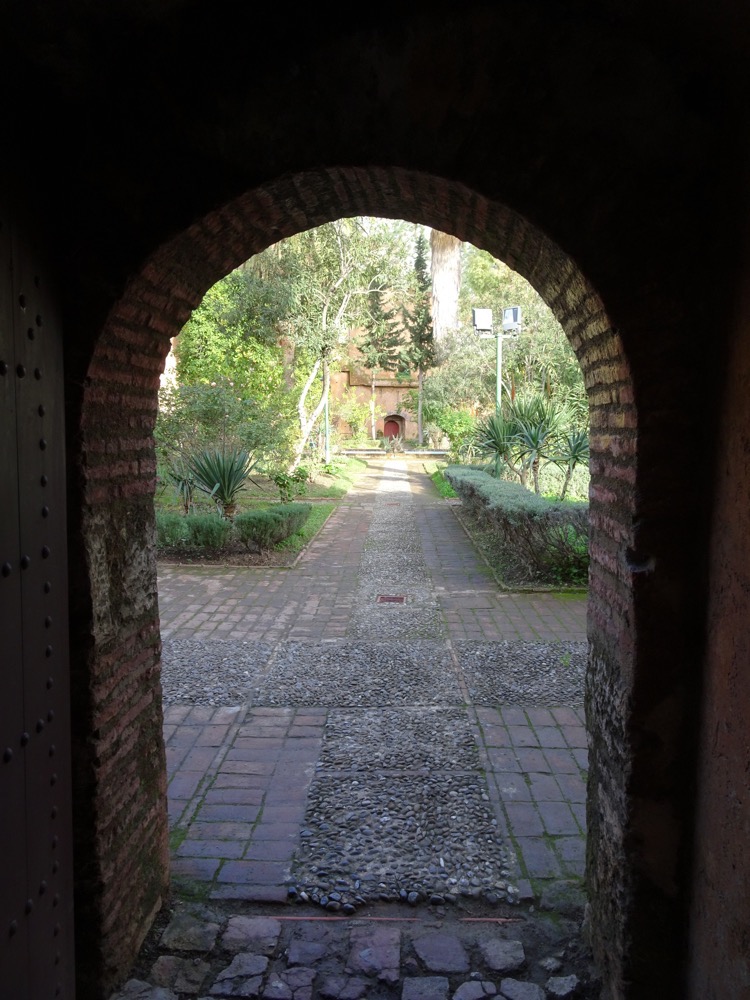 Amazingly there are at least half a dozen huge and very established gum trees in the garden. They might seem like a good idea, but I have a feeling if one of them comes down, they are giong to create one helluva mess of the ancient walls.
Amazingly there are at least half a dozen huge and very established gum trees in the garden. They might seem like a good idea, but I have a feeling if one of them comes down, they are giong to create one helluva mess of the ancient walls. 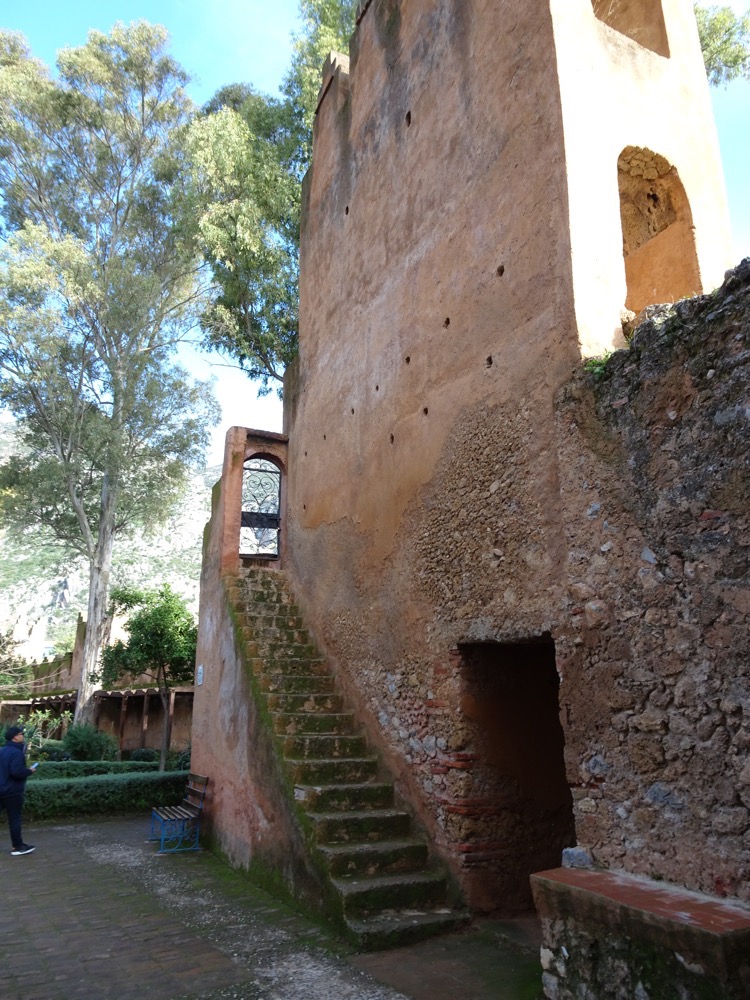
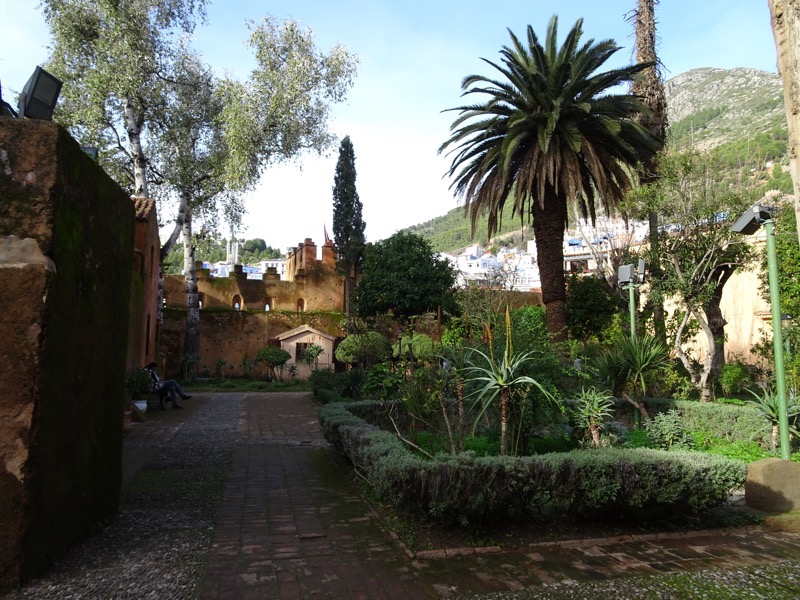
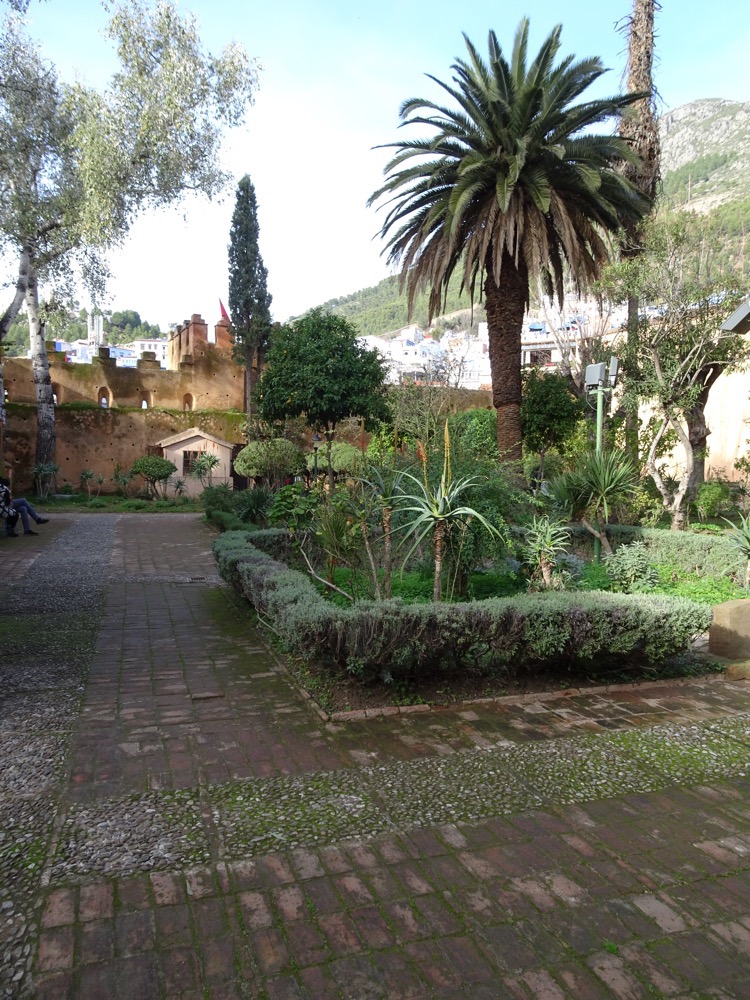
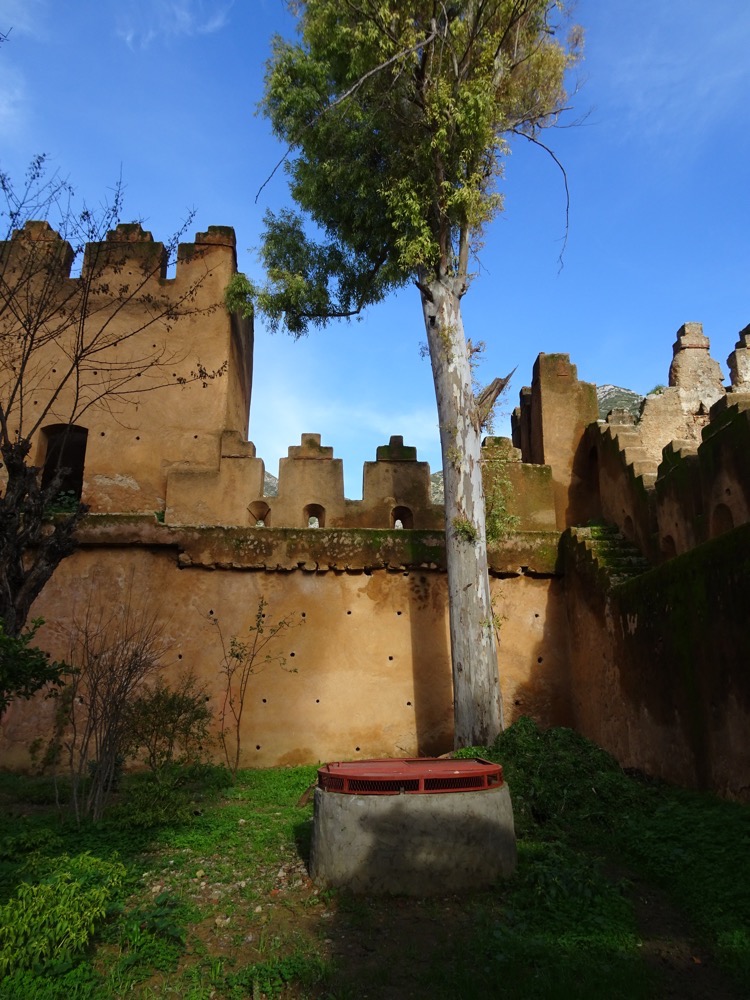
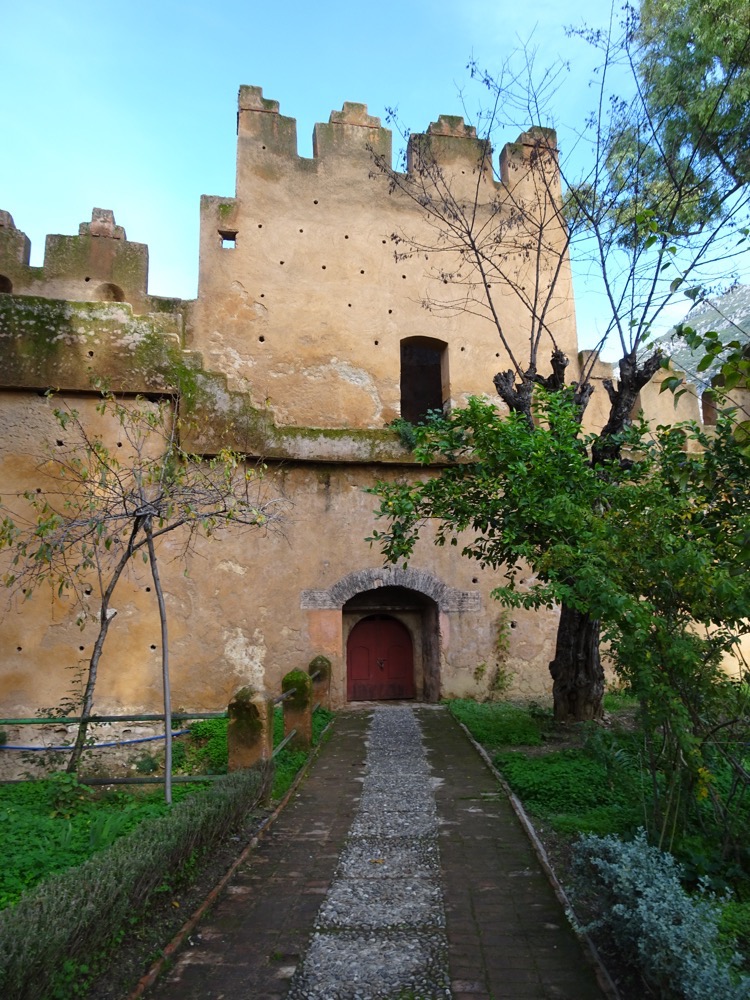
 The Center for Research and Andalusian Studies is also here and currently undergoing renovations, so we could only see the lower levels at the moment.
The Center for Research and Andalusian Studies is also here and currently undergoing renovations, so we could only see the lower levels at the moment.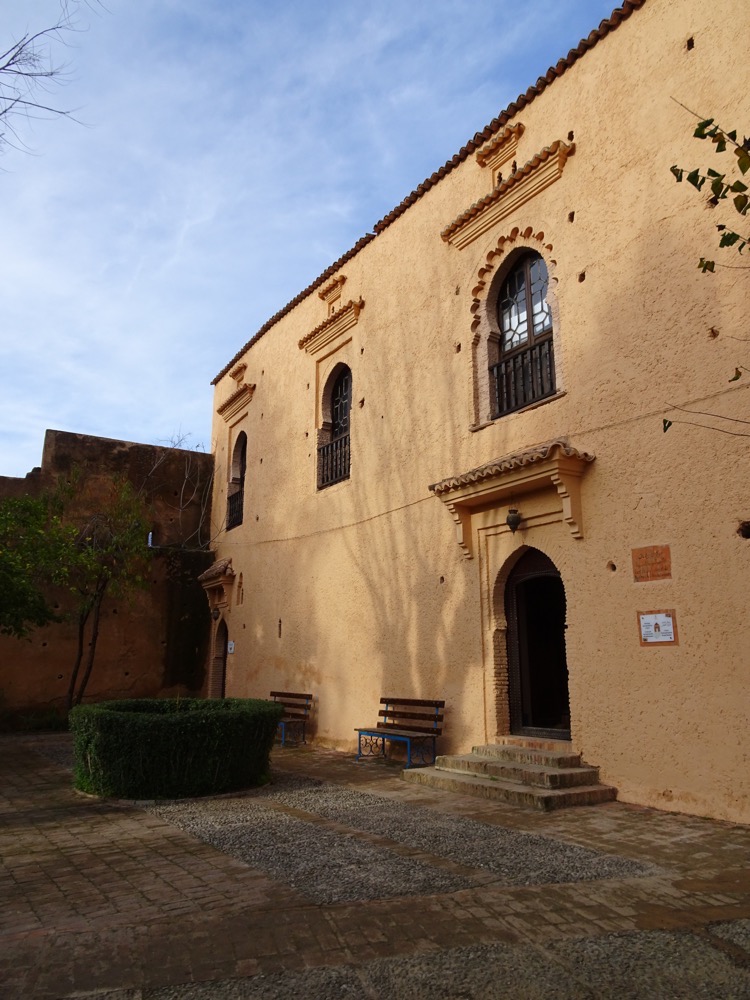
After leaving the Kasbah, we went hunting for djubbas. We saw some lovely wool ones, and for some reason the Sales Dude brought out this short pom pom’d thing for Mr K to try. Swing and a miss, Mr Sales Dude. After that it was back through the mall by which time the buskers, touts, and generally annoying people trying to get your money had all started to turn out, and we decided it was time to head back to the hotel for a bit of rest before dinner with whoever turned out to be around at the time.
After that it was back through the mall by which time the buskers, touts, and generally annoying people trying to get your money had all started to turn out, and we decided it was time to head back to the hotel for a bit of rest before dinner with whoever turned out to be around at the time. 
We had a lovely, fairly chill day. I love this town, it is visually stunning and there is lots of fun little alleys and back streets to explore. I would definitely come back here and would happily stay at the Dar Echaouen again. All round a wonderful place.
Tomorrow, however, is going to be somewhat hectic. We have a bus ride to Tangier, followed by a city tour, a meal with a local family and then an overnight train to Marrakech… am doubting the sanity of this – but hoping it won’t be too bad.

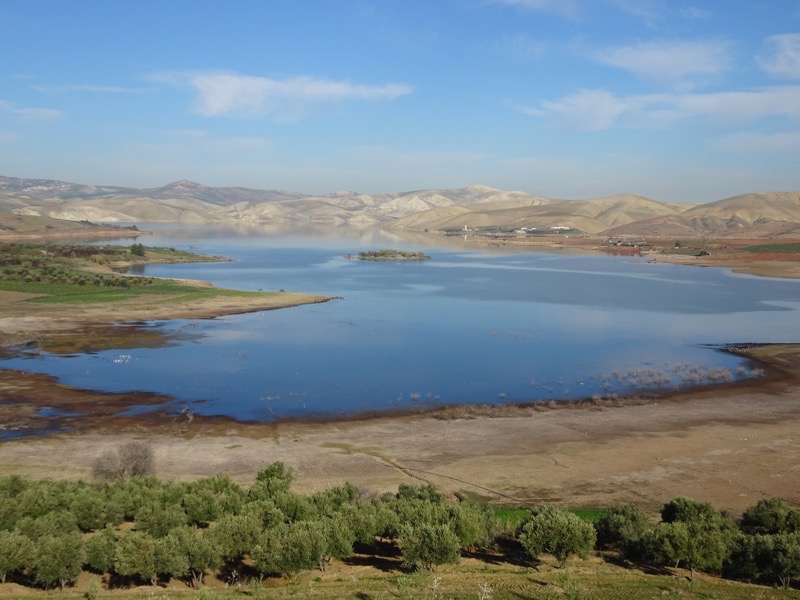 We also made a stop at an orange orchard so we could buy a few fresh oranges for our picnic. The oranges here are lovely, you can get large, cheap glasses of fresh orange juice in restaurants everywhere and the juice tastes slightly more like mandarins than the oranges at home.
We also made a stop at an orange orchard so we could buy a few fresh oranges for our picnic. The oranges here are lovely, you can get large, cheap glasses of fresh orange juice in restaurants everywhere and the juice tastes slightly more like mandarins than the oranges at home. 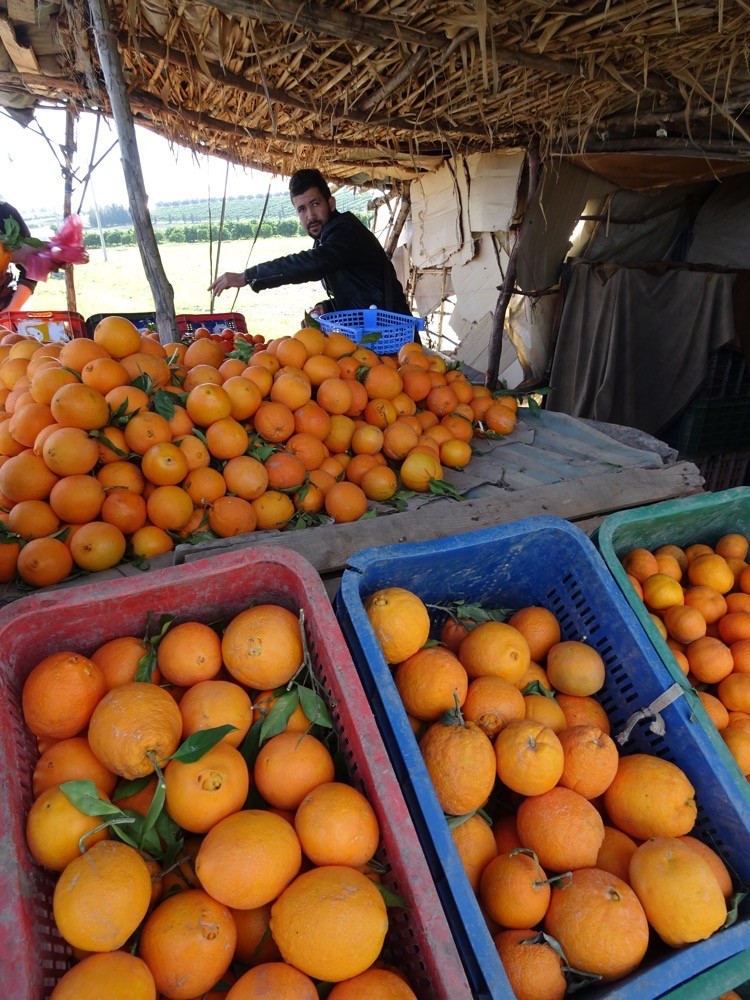 Everytime we get into the countryside, I can’t believe how green everything is…. the grass is lush and green, the trees are green, the stock looks fat and healthy… the drought at home is quickly brought into stark contrast.
Everytime we get into the countryside, I can’t believe how green everything is…. the grass is lush and green, the trees are green, the stock looks fat and healthy… the drought at home is quickly brought into stark contrast. Another stop we made was at an olive press co-op. Some of the smaller local farmers don’t have the expensive machinery required to press olives, so they bring their harvest here and their bags are numbered. They then wait their turn and put their olives through the press. The air felt thick and kinda slimy… the ground is literally dripping in olive oil.
Another stop we made was at an olive press co-op. Some of the smaller local farmers don’t have the expensive machinery required to press olives, so they bring their harvest here and their bags are numbered. They then wait their turn and put their olives through the press. The air felt thick and kinda slimy… the ground is literally dripping in olive oil.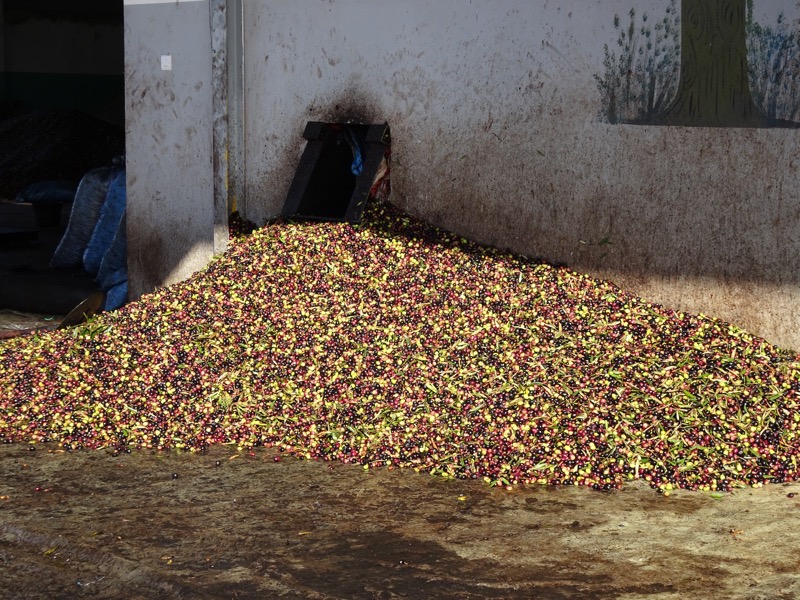 I actually disllike olives, which is weird for me as I usually love savoury and salty foods. The smell here was getting to me quite a bit. Bags of olives belonging to different farmers.
I actually disllike olives, which is weird for me as I usually love savoury and salty foods. The smell here was getting to me quite a bit. Bags of olives belonging to different farmers. A couple of the men who worked here – their clothes are soaked through with olive oil, their hands and faces black with oily gunk.
A couple of the men who worked here – their clothes are soaked through with olive oil, their hands and faces black with oily gunk. 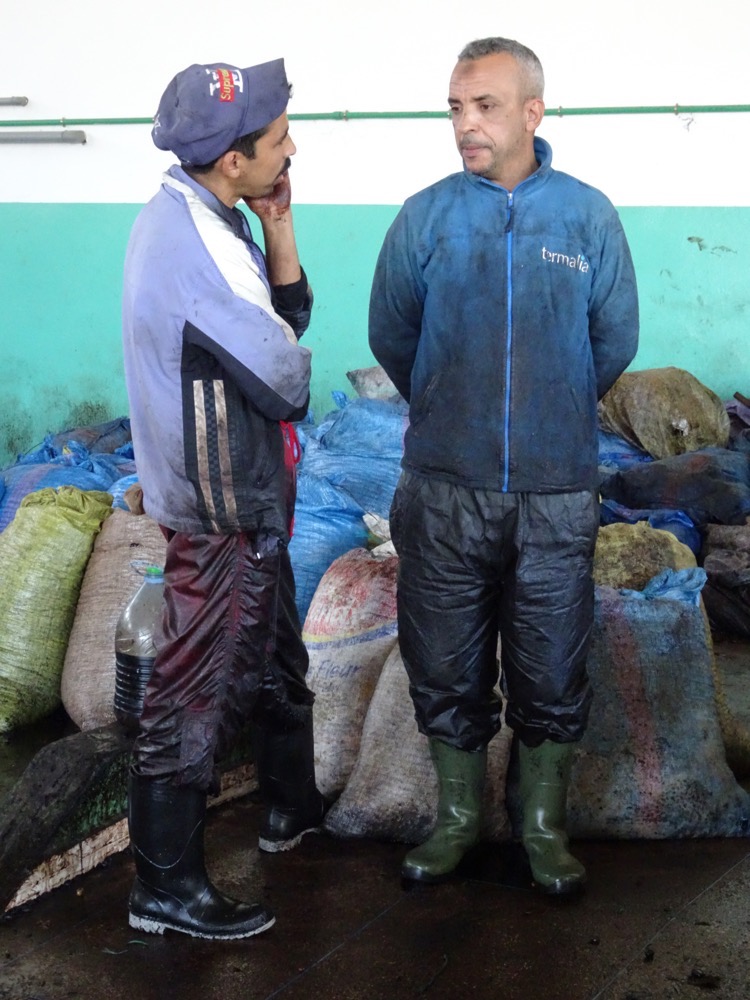 This must be one of the few largely automated processes we have seen in Morocco so far… until now, it seemed like nearly everything is done by hand.
This must be one of the few largely automated processes we have seen in Morocco so far… until now, it seemed like nearly everything is done by hand.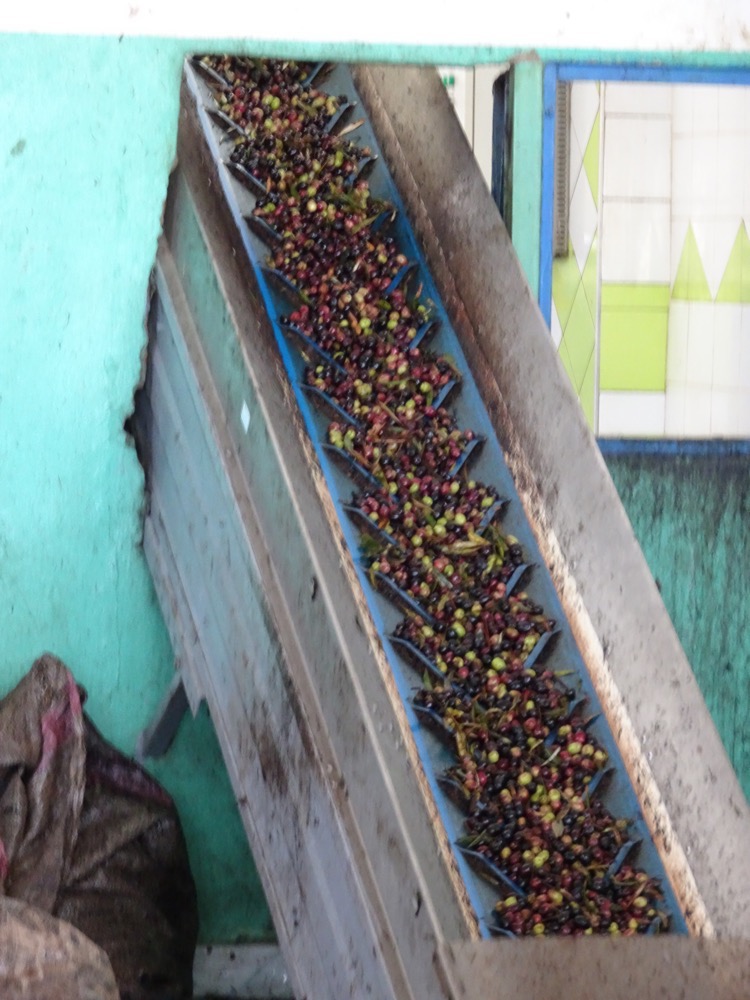

 The first press olive oil is thick and green.
The first press olive oil is thick and green.
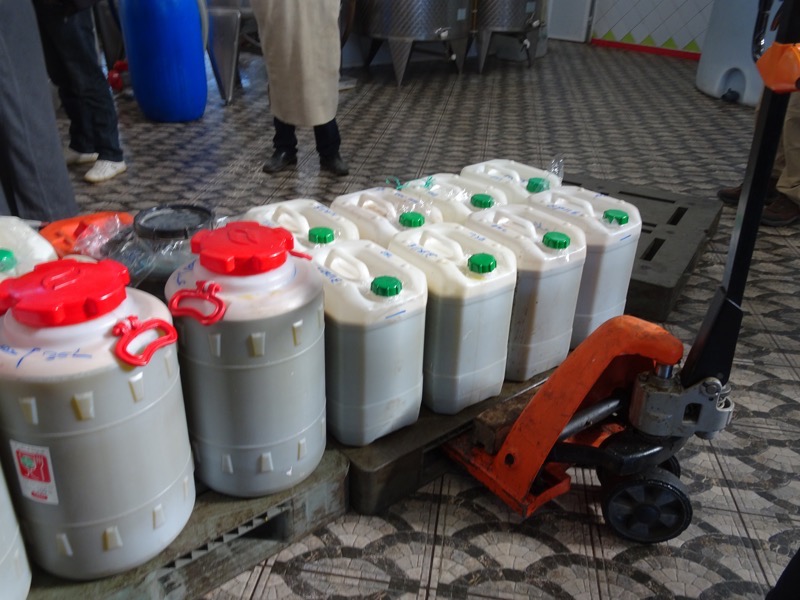 Everyone was offered a bit of bread to try it, along side other oils that had been processed for the second time and third time. I quite like my extra virgin olive oil, but not being a fan of things that actually taste like olives, I gave it a miss (good thing that turned out to be – at least two in our group said they paid for it as it went right through them and they were running for the bathroom a few hours later).
Everyone was offered a bit of bread to try it, along side other oils that had been processed for the second time and third time. I quite like my extra virgin olive oil, but not being a fan of things that actually taste like olives, I gave it a miss (good thing that turned out to be – at least two in our group said they paid for it as it went right through them and they were running for the bathroom a few hours later).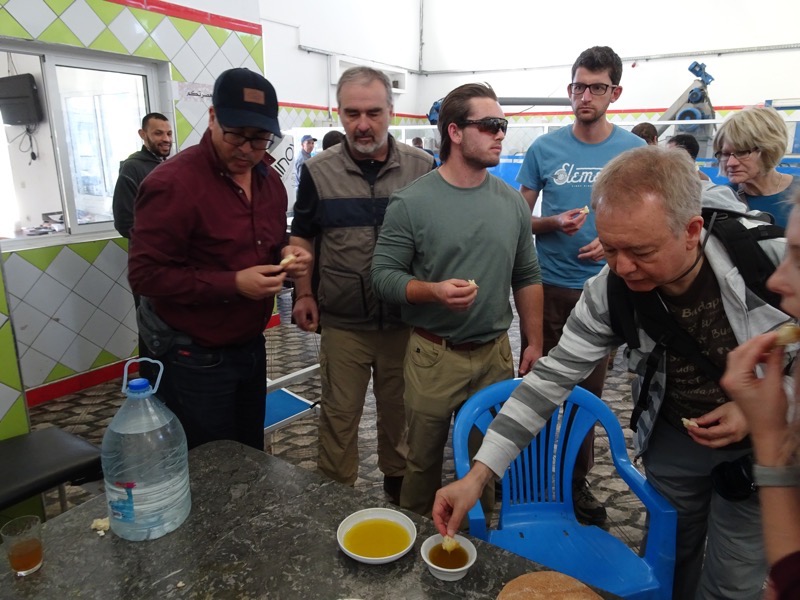
 Anyway, back on the bus and a few kilometers down the road we stopped for a picnic lunch. Before leaving Fez, we went to an enormous supermarket and all picked up some tidbits for lunch. We had some very tasty sandwiches and wraps with meats, cheeses, nuts, dates, figs etc. We even managed to buy some drinks so many had picked up some beers to have with lunch.
Anyway, back on the bus and a few kilometers down the road we stopped for a picnic lunch. Before leaving Fez, we went to an enormous supermarket and all picked up some tidbits for lunch. We had some very tasty sandwiches and wraps with meats, cheeses, nuts, dates, figs etc. We even managed to buy some drinks so many had picked up some beers to have with lunch. 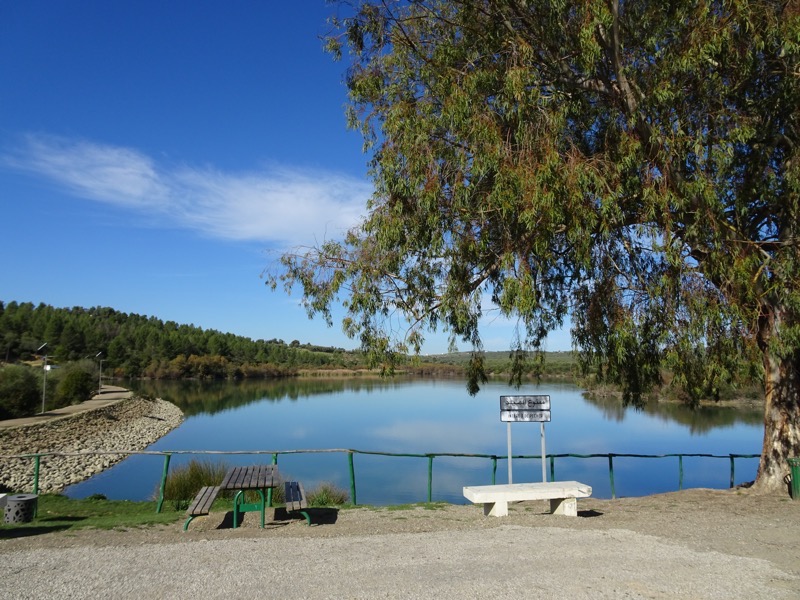 Hay stacks for the winter.
Hay stacks for the winter. 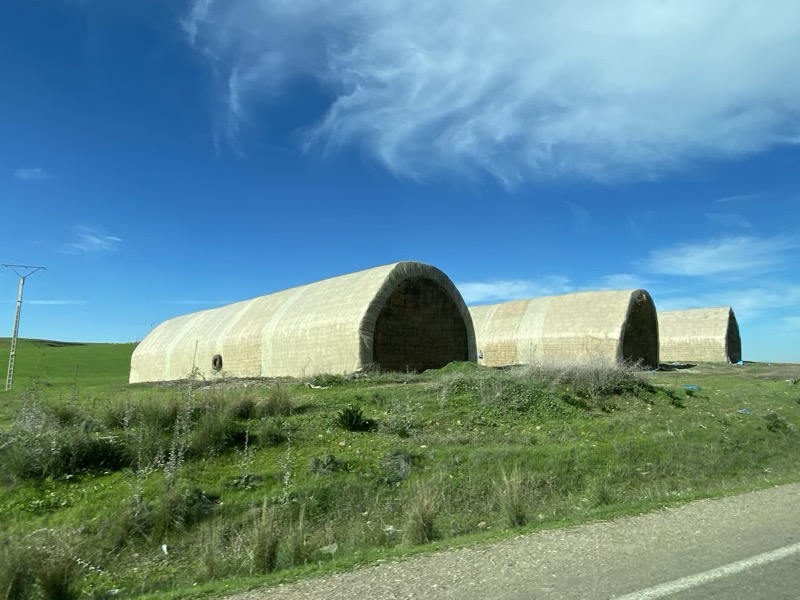 Everywhere, you could see enormous rows of prickly pear. They use it for a few different purposes – hedgerows are grown to make fencing to keep their animals in. The plant itself is eaten in some dishes, and the flowers are used for a natural dye. At home it’s a noxious weed.
Everywhere, you could see enormous rows of prickly pear. They use it for a few different purposes – hedgerows are grown to make fencing to keep their animals in. The plant itself is eaten in some dishes, and the flowers are used for a natural dye. At home it’s a noxious weed.  About another hour or so down the road and we arrived at Chefchaouen. Chefchaouen is nestled between two mountain peaks – the word itself actually means ‘two mountian horns’ – and is located at 560m above sealevel, about 70kms from the Mediterranean to the north and 130kms from the Atlantic to the west. From this lookout we could see some glimpses of the blue walls this city is so famous for.
About another hour or so down the road and we arrived at Chefchaouen. Chefchaouen is nestled between two mountain peaks – the word itself actually means ‘two mountian horns’ – and is located at 560m above sealevel, about 70kms from the Mediterranean to the north and 130kms from the Atlantic to the west. From this lookout we could see some glimpses of the blue walls this city is so famous for.
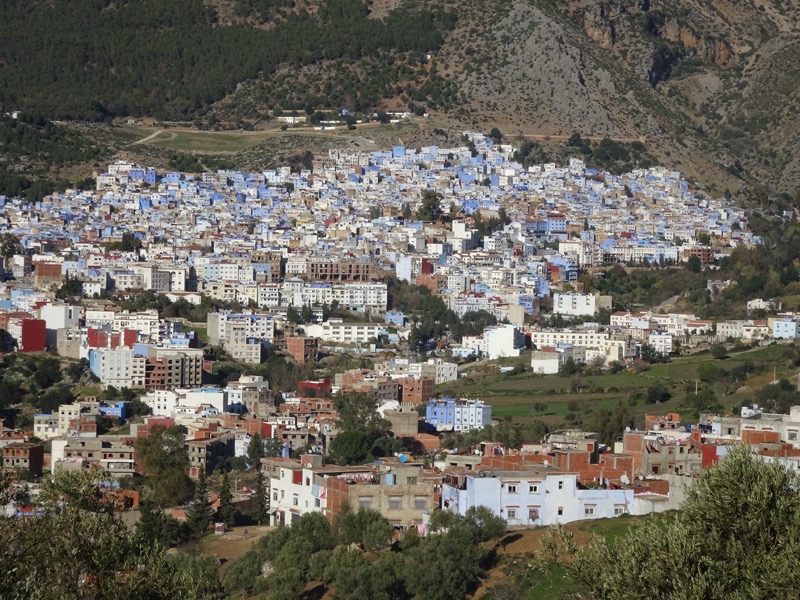 We arrived at our hotel Darechaouen and were greeted with cups of Moroccan mint tea and date cookies while they sorted the rooms out.
We arrived at our hotel Darechaouen and were greeted with cups of Moroccan mint tea and date cookies while they sorted the rooms out. 
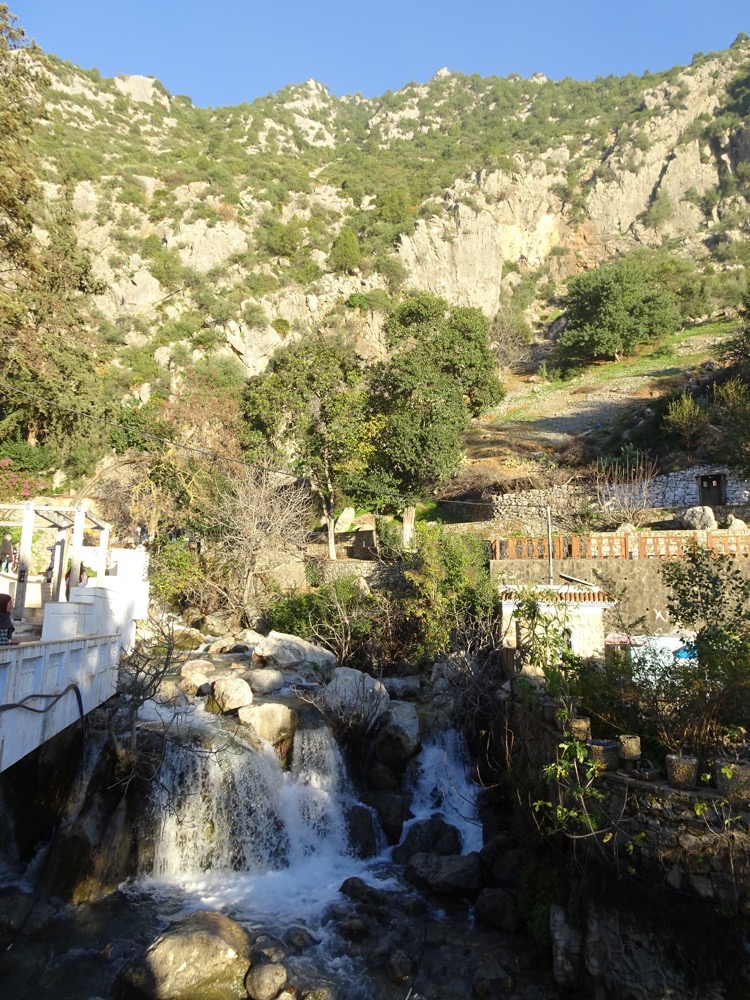
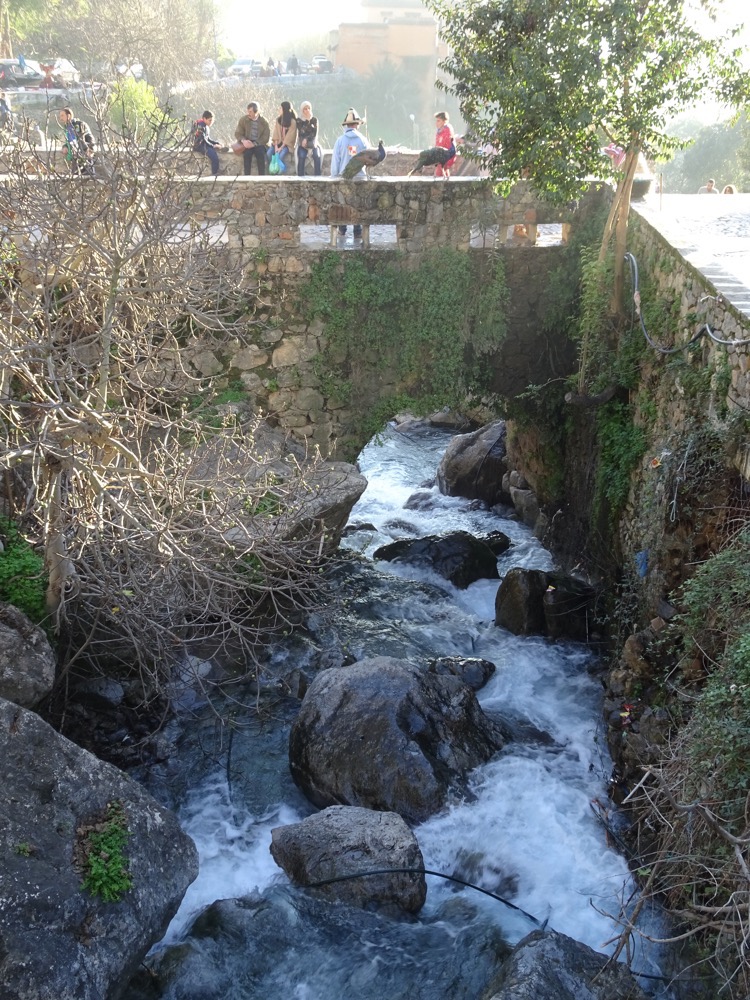 After the winter snow melts, this spring will have twice as much water pouring from it.
After the winter snow melts, this spring will have twice as much water pouring from it.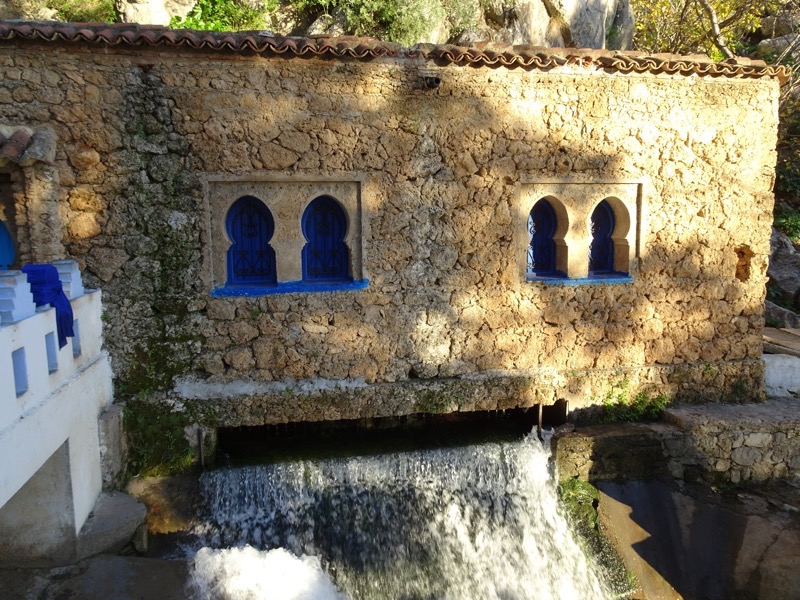
 Directly to the left of these four ladies was a bench with four men, presumably their husbands… “What you talking about?” – “Shopping” … “What you talking about?” – “Football”
Directly to the left of these four ladies was a bench with four men, presumably their husbands… “What you talking about?” – “Shopping” … “What you talking about?” – “Football”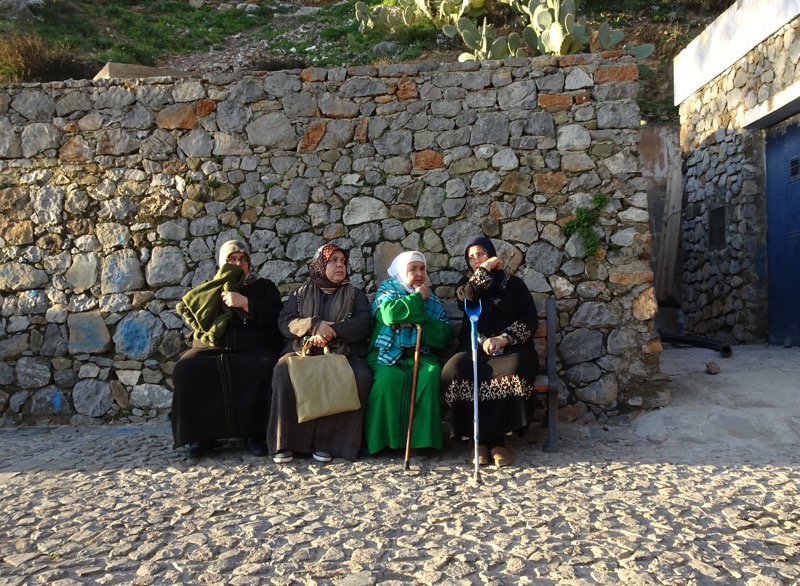
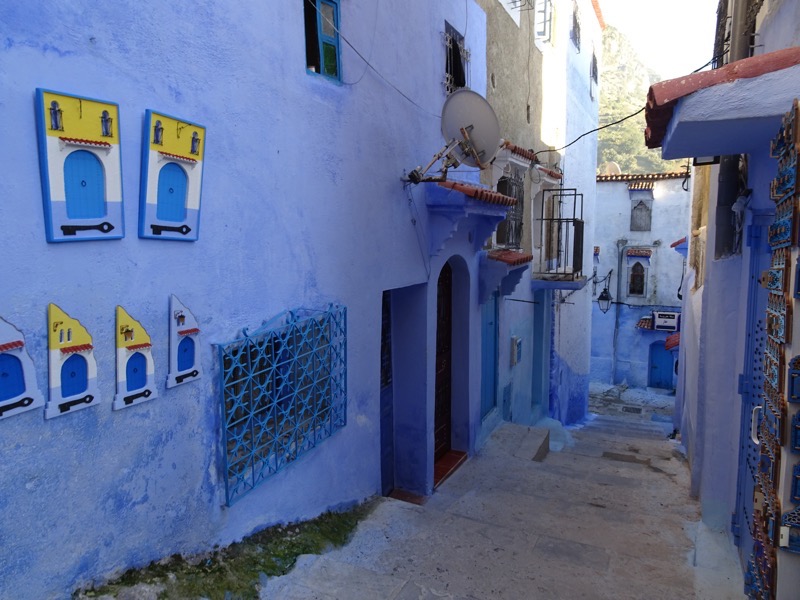



 Want to see my scoot?!
Want to see my scoot?! The surrounding countryside is well known as a prolific source of ‘kief’ – marijuana, and as we walked the town you would semiregularly get a strong whiff of pot as you rounded a corner or walked past a shop.
The surrounding countryside is well known as a prolific source of ‘kief’ – marijuana, and as we walked the town you would semiregularly get a strong whiff of pot as you rounded a corner or walked past a shop. There are public fountains dotting the town that are gravity fed directly from the mountain spring – hundreds of years old, they have seen a lot of use.
There are public fountains dotting the town that are gravity fed directly from the mountain spring – hundreds of years old, they have seen a lot of use. There are quaint little alleyways in every direction, most of them steep and because of the fountains located around the place, most of the walkways were slightly wet and rather slippery.
There are quaint little alleyways in every direction, most of them steep and because of the fountains located around the place, most of the walkways were slightly wet and rather slippery. Chefchaouen is also knowns for it’s remarkably varied and popular blue doors… so many gates and doors everywhere – some simple, some elaborately painted, some enormous and some so small I have to duck to go in.
Chefchaouen is also knowns for it’s remarkably varied and popular blue doors… so many gates and doors everywhere – some simple, some elaborately painted, some enormous and some so small I have to duck to go in. This (below) is one of the most famous photo spots in the city… Samirr warned us that if there were Chinese tourists here, we would ‘have to come back next year’ rather than wait for them to finish taking their photos. The locals are completely over the habit of Chinese tourists to stand in front of any famous object and take fifty photos of themselves in a myriad of very posed positions (tbh, so am I – Iceland last year was a real test of patience on that front).
This (below) is one of the most famous photo spots in the city… Samirr warned us that if there were Chinese tourists here, we would ‘have to come back next year’ rather than wait for them to finish taking their photos. The locals are completely over the habit of Chinese tourists to stand in front of any famous object and take fifty photos of themselves in a myriad of very posed positions (tbh, so am I – Iceland last year was a real test of patience on that front).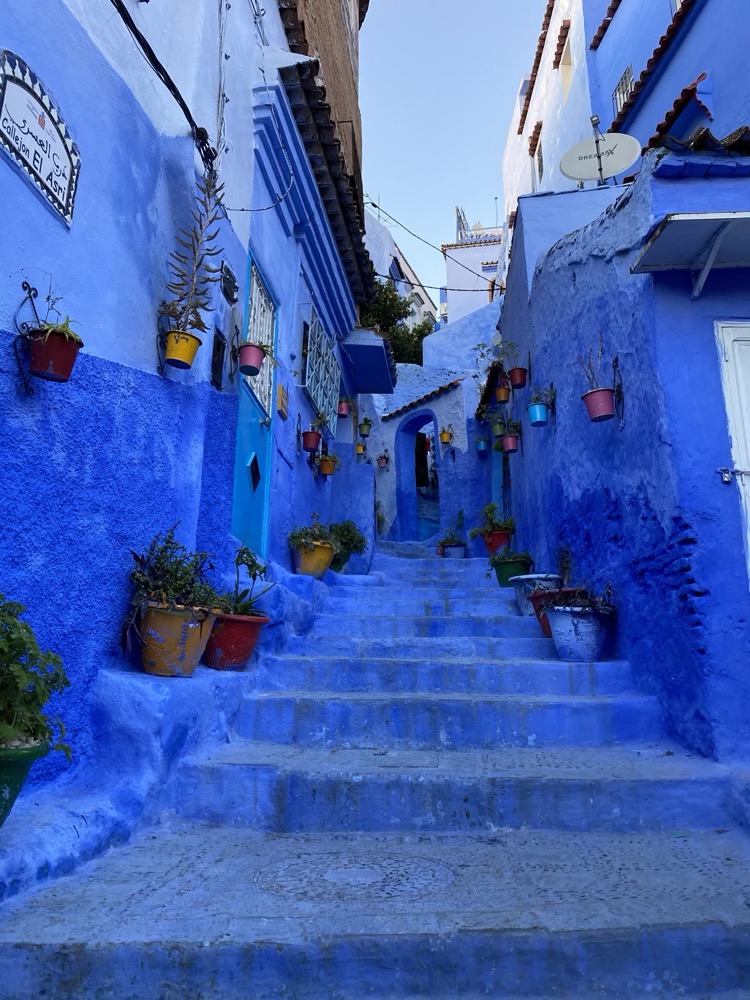 Samirr was impressed at my crowd management skills, our small tour group was pleased to have their chance at photos sans Chinese tourists, and I was simply stunned at the amazing beautiful blue colours of the steps on this tiny little street that attracts people from all over the world.
Samirr was impressed at my crowd management skills, our small tour group was pleased to have their chance at photos sans Chinese tourists, and I was simply stunned at the amazing beautiful blue colours of the steps on this tiny little street that attracts people from all over the world.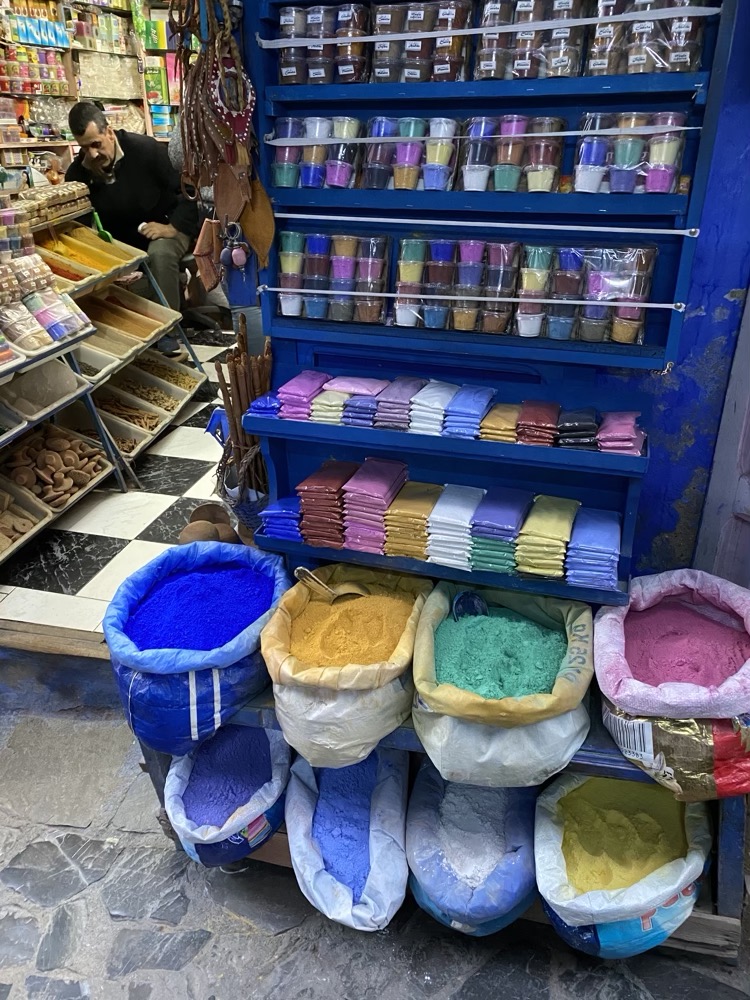

 I know it looks like the town is nearly empty in most of these photos – but this is just my judicious sense of timing. Pick a spot and wait for the person to move right out of frame and *click* before someone moves into the left of frame. But trust me, there were plenty of people around and the medina only became busier as the sun went down and the locals came to town for the restaurants and clubs.
I know it looks like the town is nearly empty in most of these photos – but this is just my judicious sense of timing. Pick a spot and wait for the person to move right out of frame and *click* before someone moves into the left of frame. But trust me, there were plenty of people around and the medina only became busier as the sun went down and the locals came to town for the restaurants and clubs. The town’s main square, which is pretty much at the bottom of the steep medina.
The town’s main square, which is pretty much at the bottom of the steep medina.  Still.. there were further little alleyways winding further down the mountain and we were diving back into them to find a Berber carpet shop.
Still.. there were further little alleyways winding further down the mountain and we were diving back into them to find a Berber carpet shop.  As tradition dictates, one must go carpet/rug shopping when in Turkey or Pakistan or India or Morocco and well, nearly everywhere from North Africa to the Subcontinent!
As tradition dictates, one must go carpet/rug shopping when in Turkey or Pakistan or India or Morocco and well, nearly everywhere from North Africa to the Subcontinent! Abdullah, our host offered us all sweet Moroccan mint tea… very sweet this time and quite refreshing. This is also part of the tradition, coming right before the selling! In Turkey, I think they have much more success with the selling part, as they often ply customers with beer and raki instead. Here, have a buzz, buy a rug!
Abdullah, our host offered us all sweet Moroccan mint tea… very sweet this time and quite refreshing. This is also part of the tradition, coming right before the selling! In Turkey, I think they have much more success with the selling part, as they often ply customers with beer and raki instead. Here, have a buzz, buy a rug!  The group waiting for the rugs to start falling.
The group waiting for the rugs to start falling.
 And so they did… Abdullah*, threw down about fifty rugs in total, all of them locally made by Berber tribes, and in a wide variety of colours and sizes. These rugs are unlike any I’ve seen before, predominantly kilim style and most of them asymmetrical in design – which makes me twitch like all giddyup. So I was pretty safe from any unplanned rug purchases.
And so they did… Abdullah*, threw down about fifty rugs in total, all of them locally made by Berber tribes, and in a wide variety of colours and sizes. These rugs are unlike any I’ve seen before, predominantly kilim style and most of them asymmetrical in design – which makes me twitch like all giddyup. So I was pretty safe from any unplanned rug purchases. Anyway after our rug shopping experience, where no one found anything they liked, we went to a restaurnt called, Restaurant Bab Ssour, for a lovely rooftop dining and some delicious local tagine dishes.
Anyway after our rug shopping experience, where no one found anything they liked, we went to a restaurnt called, Restaurant Bab Ssour, for a lovely rooftop dining and some delicious local tagine dishes.  The view across the medina from the rooftop terrace.
The view across the medina from the rooftop terrace.
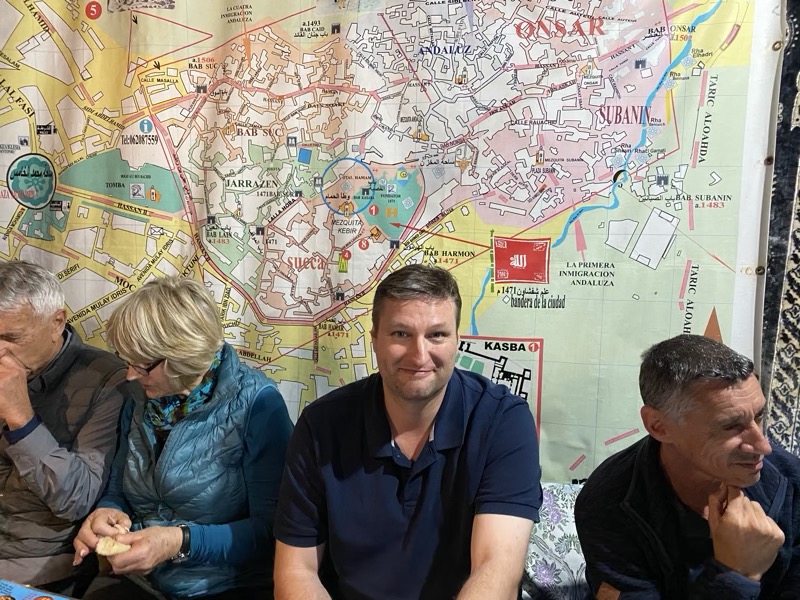 Goat cheese is a speciality local dish, served with balsamic. It was really good and had a smooth creamy texture.
Goat cheese is a speciality local dish, served with balsamic. It was really good and had a smooth creamy texture. Goat tagine with plums! The meat was just falling off the bone and absolutely delicious.
Goat tagine with plums! The meat was just falling off the bone and absolutely delicious.
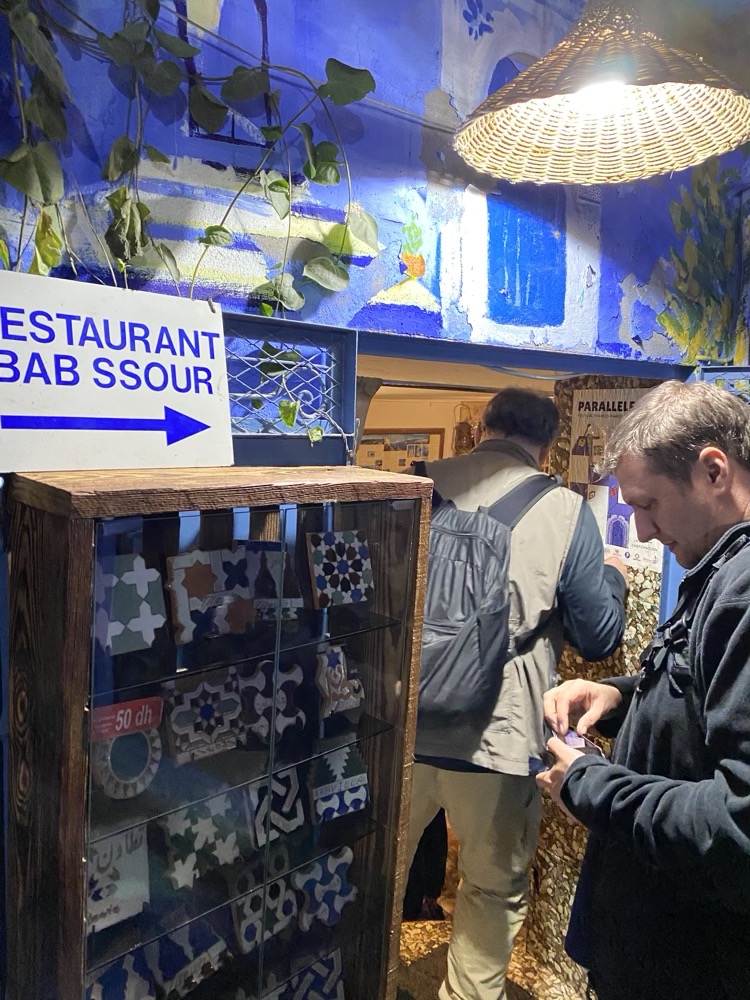 After our long day of driving followed by what was supposed to be a short orientation walk (6kms), we head back to the hotel for a vodka tonic and crashed in our big luxurious bed.
After our long day of driving followed by what was supposed to be a short orientation walk (6kms), we head back to the hotel for a vodka tonic and crashed in our big luxurious bed.

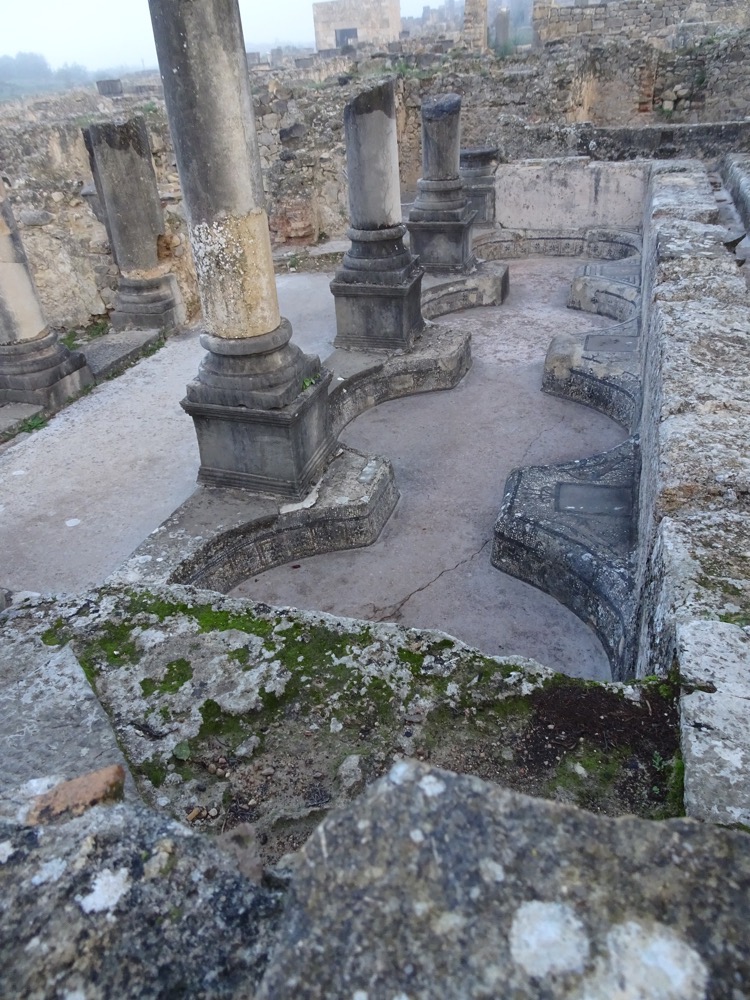
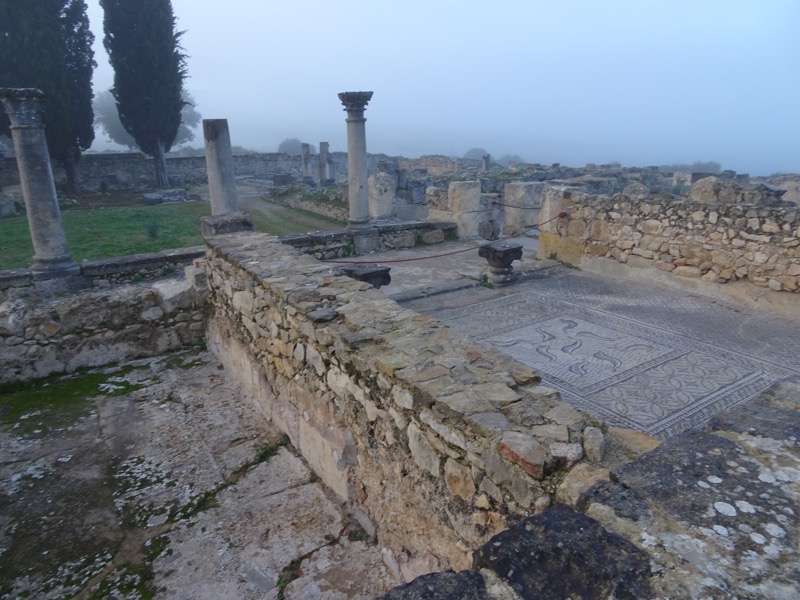 A terrace that would have been an open courtyard for dining with lovely dolphins in the mosaic floors.
A terrace that would have been an open courtyard for dining with lovely dolphins in the mosaic floors.

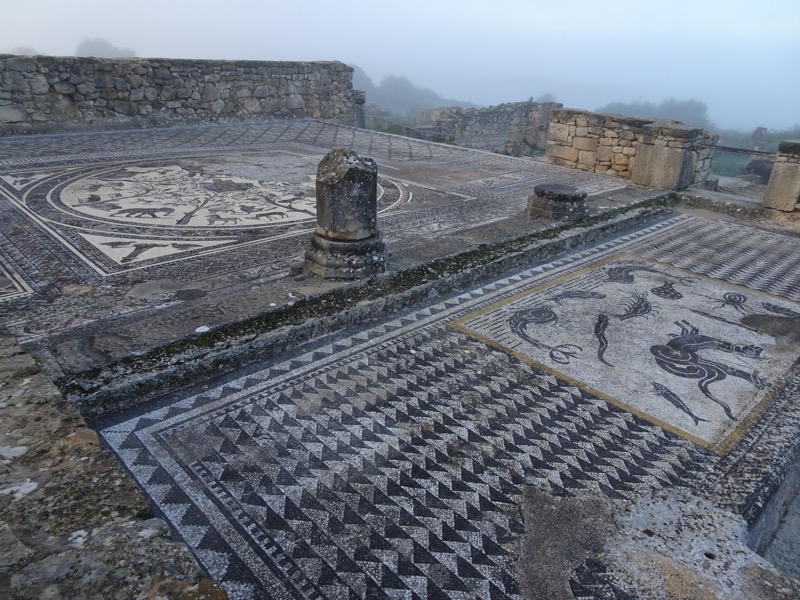
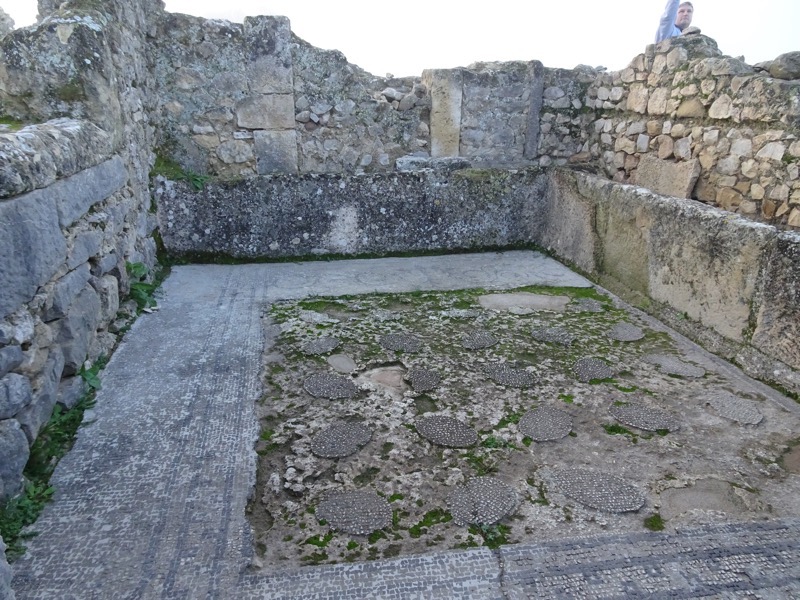 Being made of natural stone rather than ceramic, the mosaics are in incredible condition given their age and the disruptions to the civilization here.
Being made of natural stone rather than ceramic, the mosaics are in incredible condition given their age and the disruptions to the civilization here. 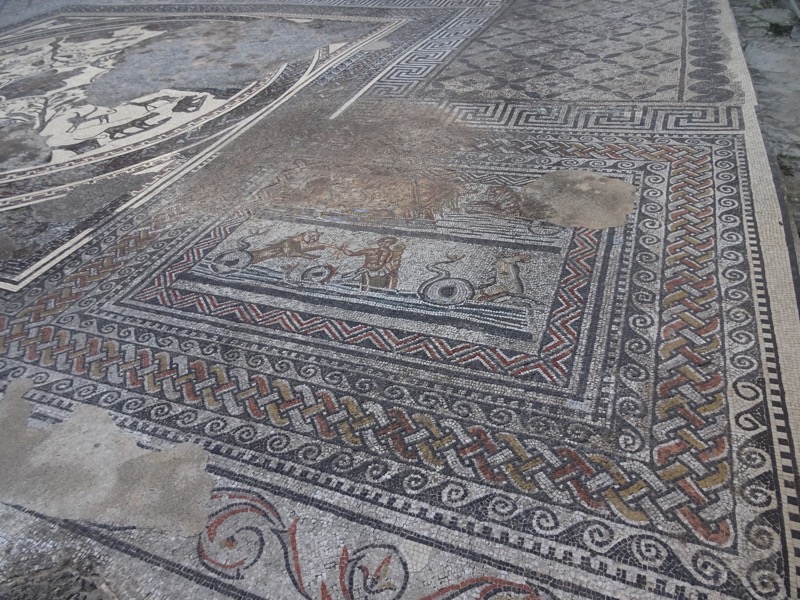 A reconstructed olive press that shows how the town made much of its wealth:
A reconstructed olive press that shows how the town made much of its wealth: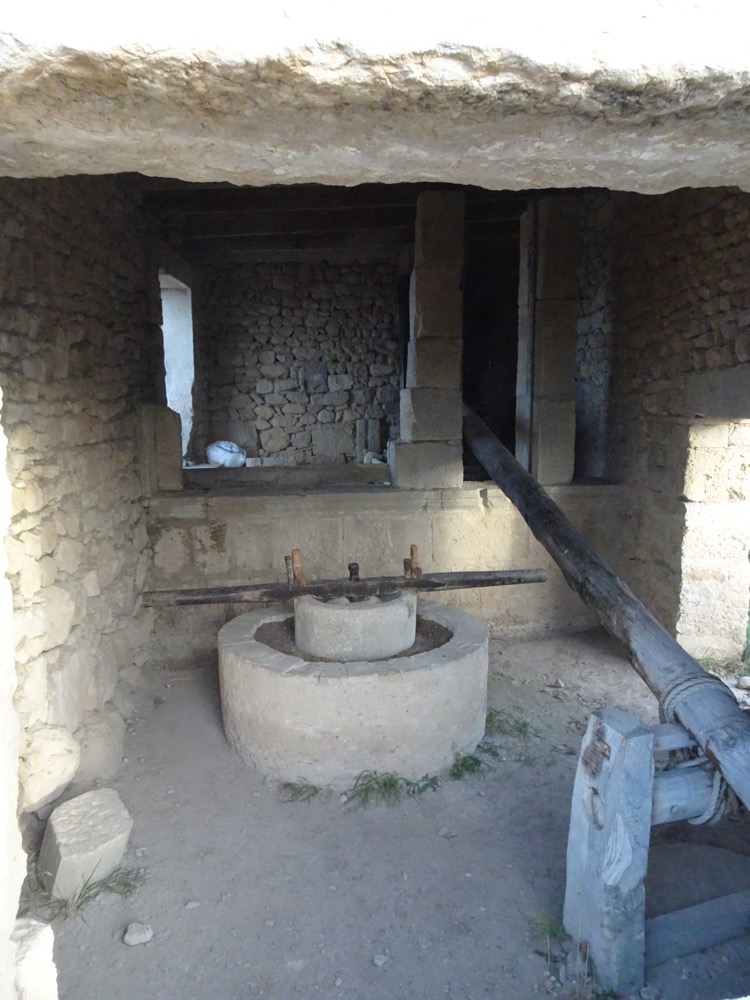 We arrived at the site very early and were the first visitors, so we had the place predominantly to ourselves… there was a very moody early morning fog that lifted about half an hour after we arrived.
We arrived at the site very early and were the first visitors, so we had the place predominantly to ourselves… there was a very moody early morning fog that lifted about half an hour after we arrived.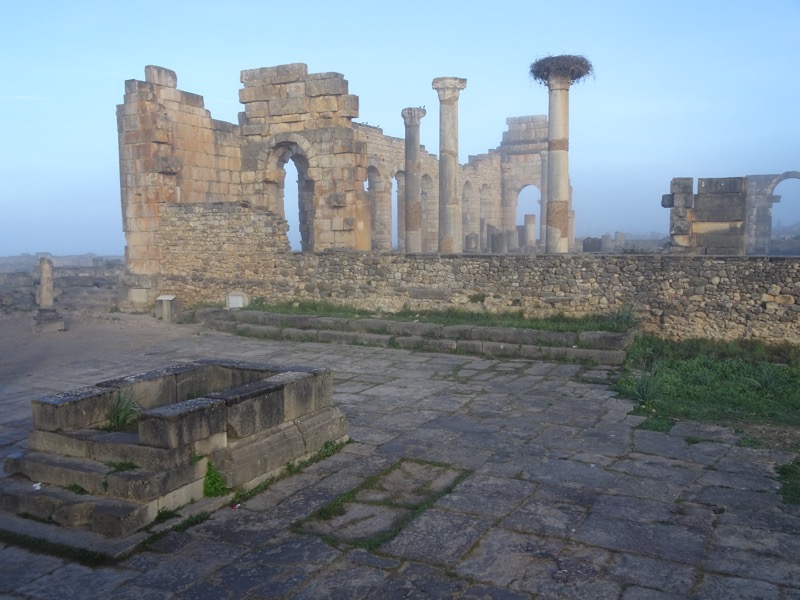
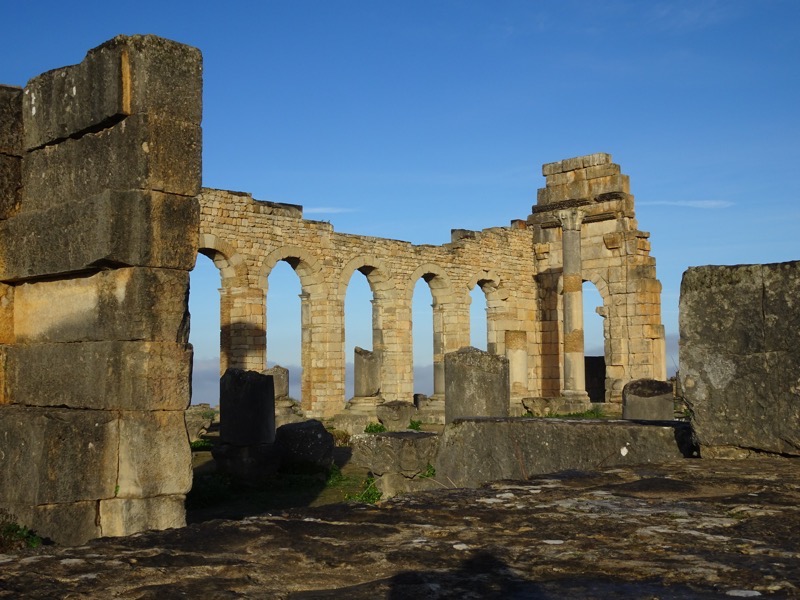 The tops of ancient columns seem to be a favoured place for swallows and storks to build their nests…
The tops of ancient columns seem to be a favoured place for swallows and storks to build their nests…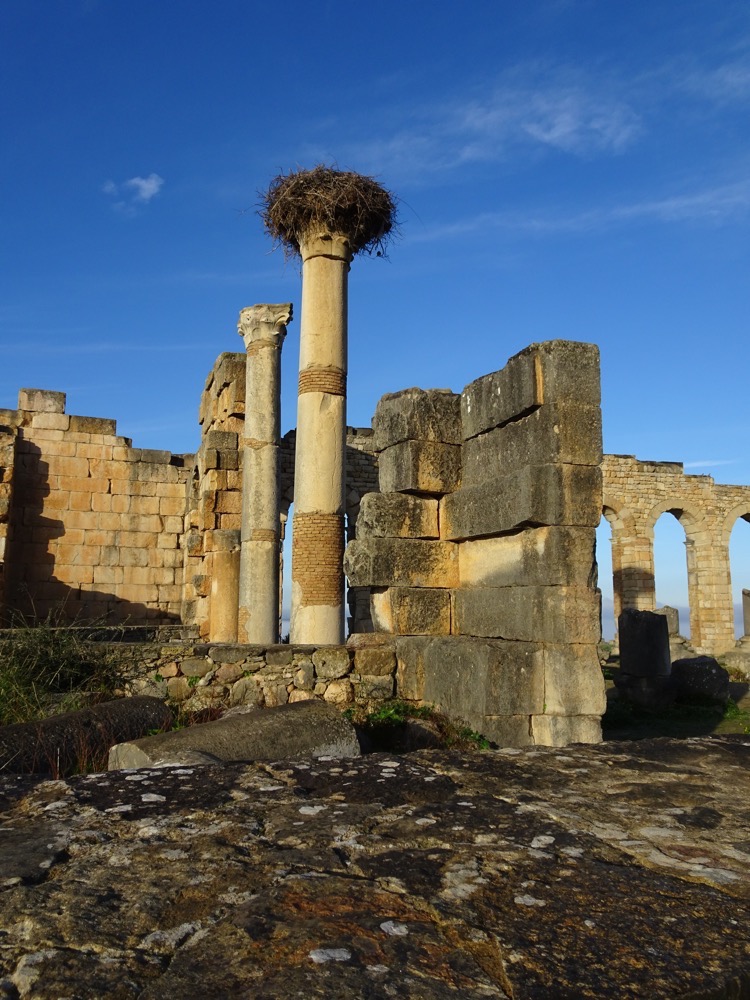 Front facade of the Basilica
Front facade of the Basilica 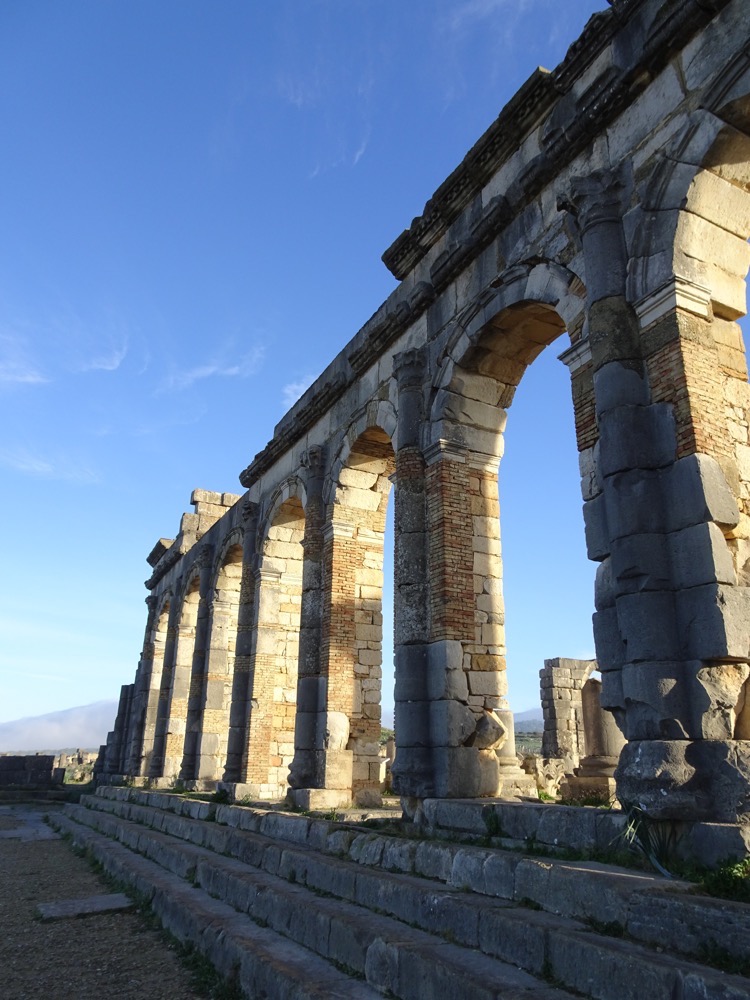
 Interior of the Basilica
Interior of the Basilica
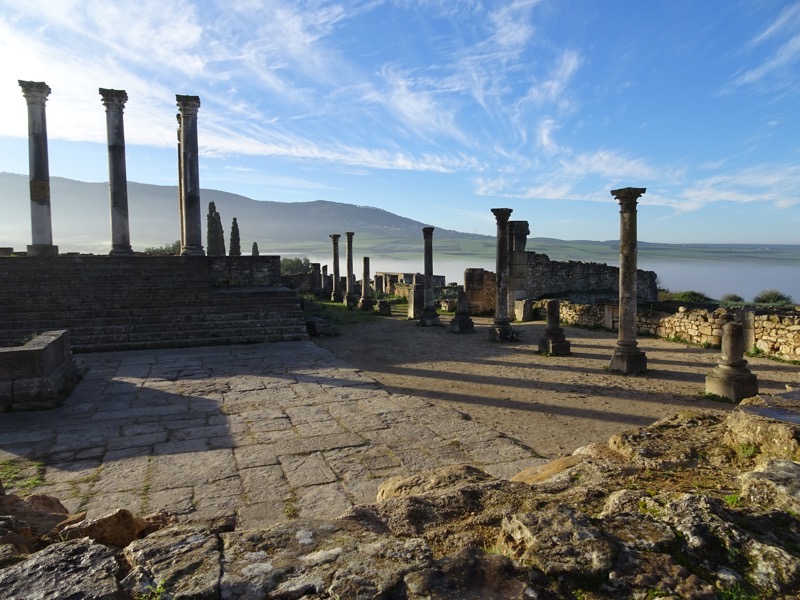


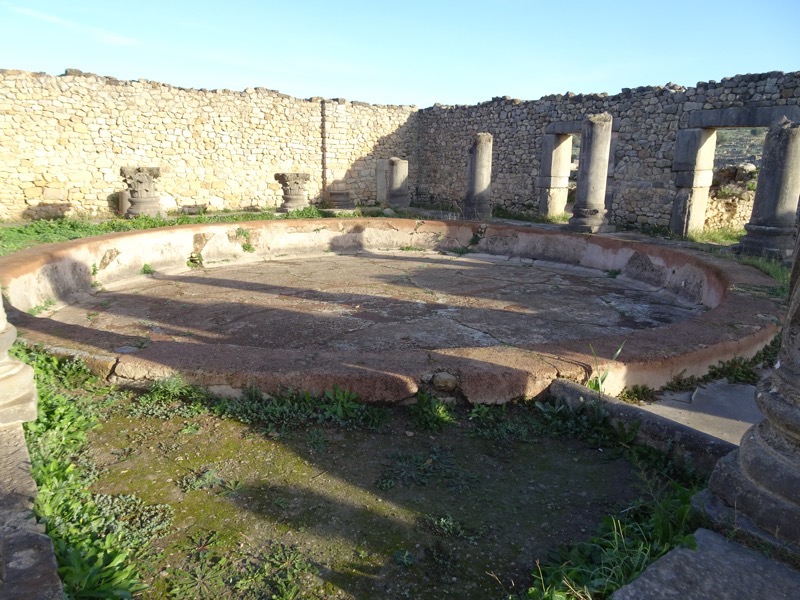
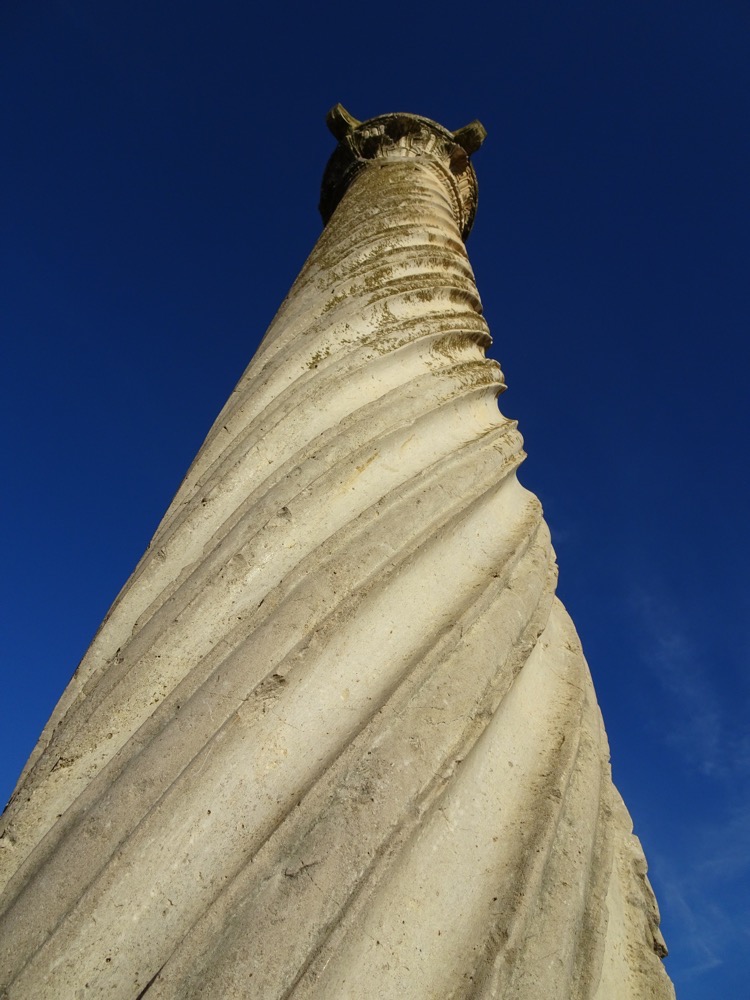 A somewhat damaged mosaic depicting the Goddess DIana… Diana herself has been removed from the mosaic, most likely by the French who took many artefacts from the site and sent them back to France.
A somewhat damaged mosaic depicting the Goddess DIana… Diana herself has been removed from the mosaic, most likely by the French who took many artefacts from the site and sent them back to France.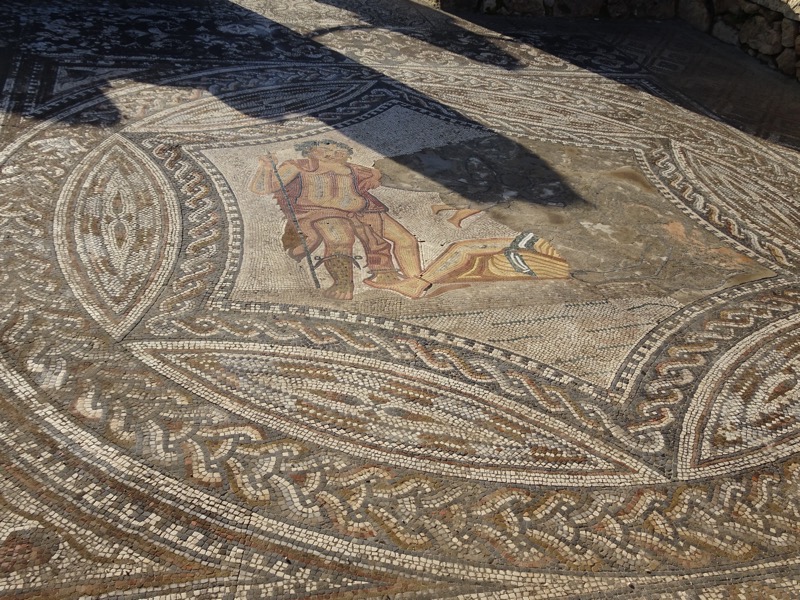 This wonderful, large terrace space depicts the Twelve Trials of Hercules.
This wonderful, large terrace space depicts the Twelve Trials of Hercules.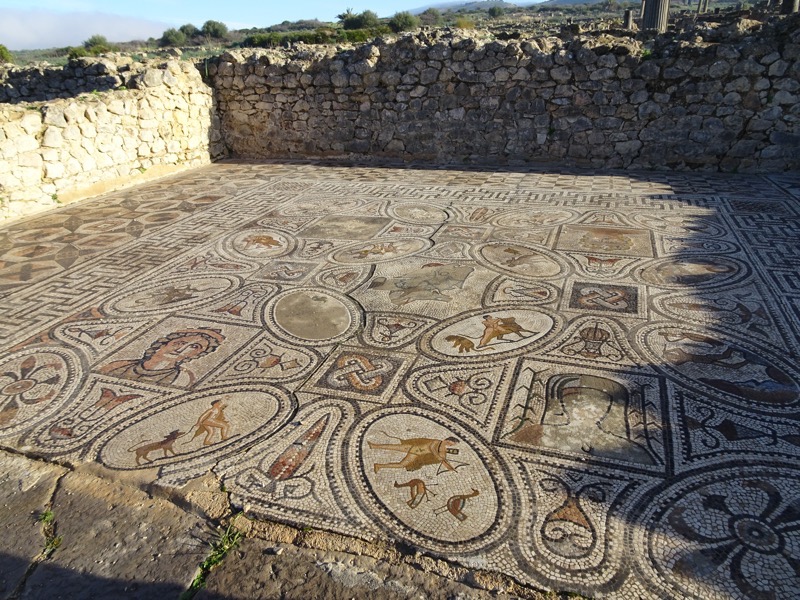
 Shooting lions, wrestling pheasants, that sort of thing…
Shooting lions, wrestling pheasants, that sort of thing… A spa area which had a fountain in the middle and visitors could sit in the semicircular cut out spaces and enjoy the fresh waters from the fountains.
A spa area which had a fountain in the middle and visitors could sit in the semicircular cut out spaces and enjoy the fresh waters from the fountains.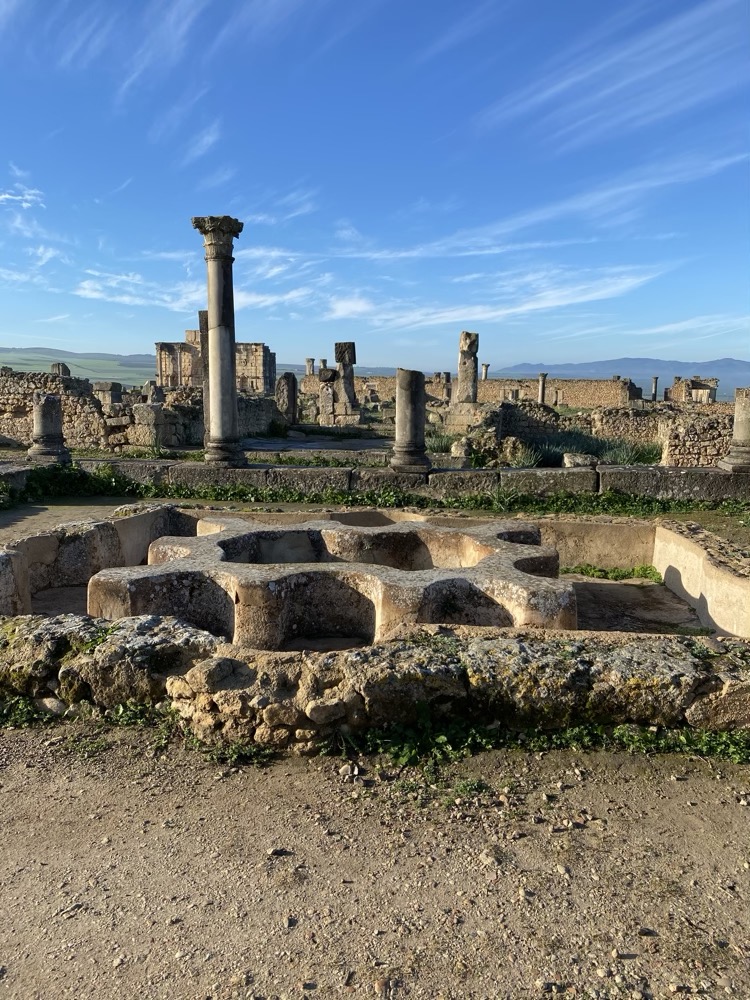
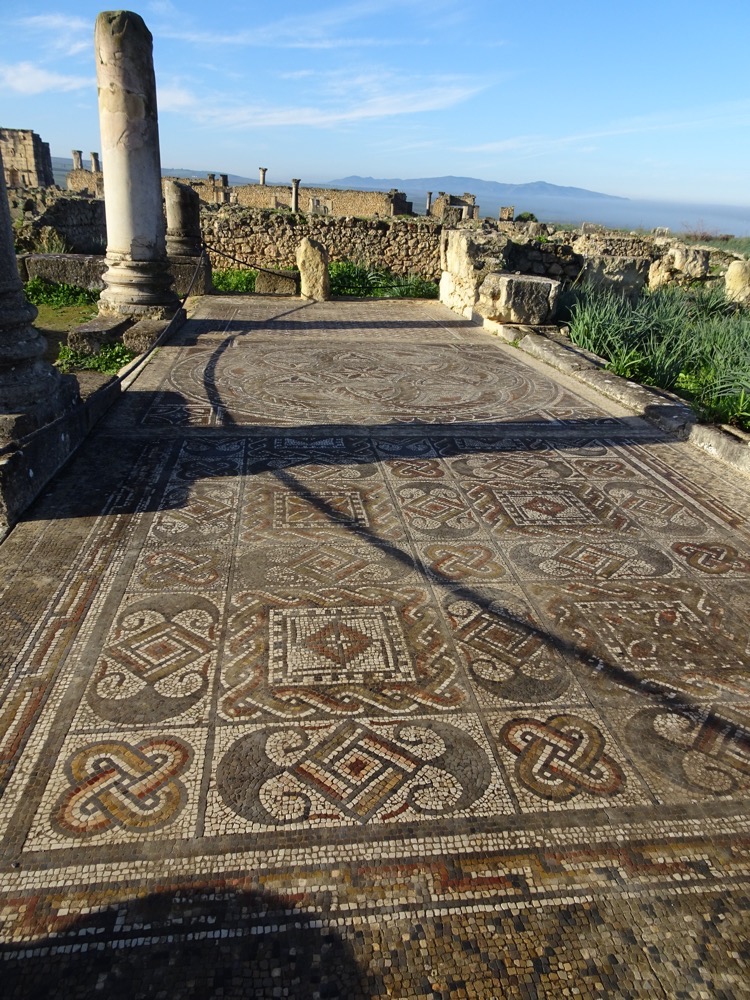 The Four Seasons depicted in the floors of the House of Hercules.
The Four Seasons depicted in the floors of the House of Hercules. 

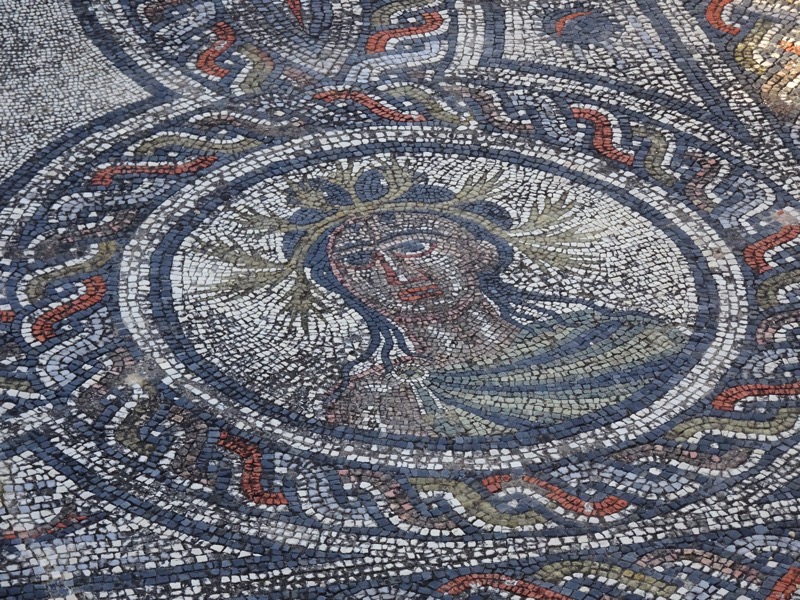
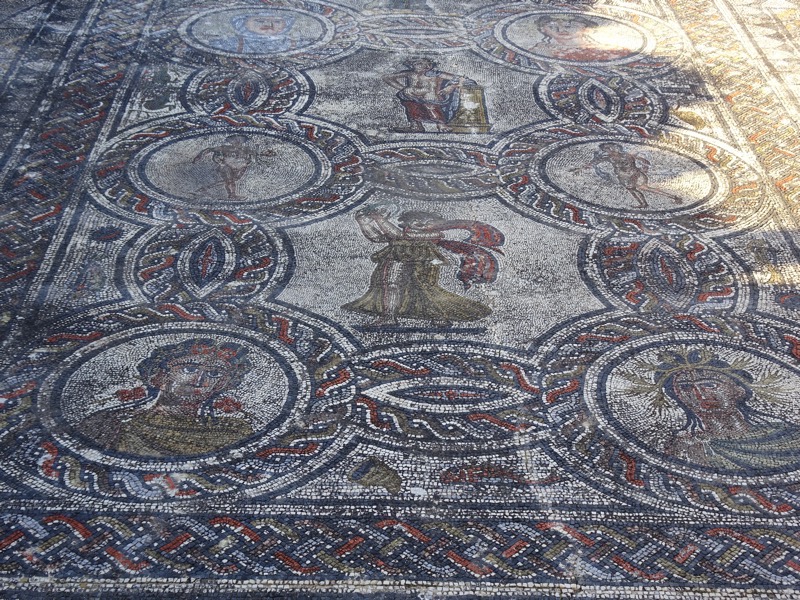
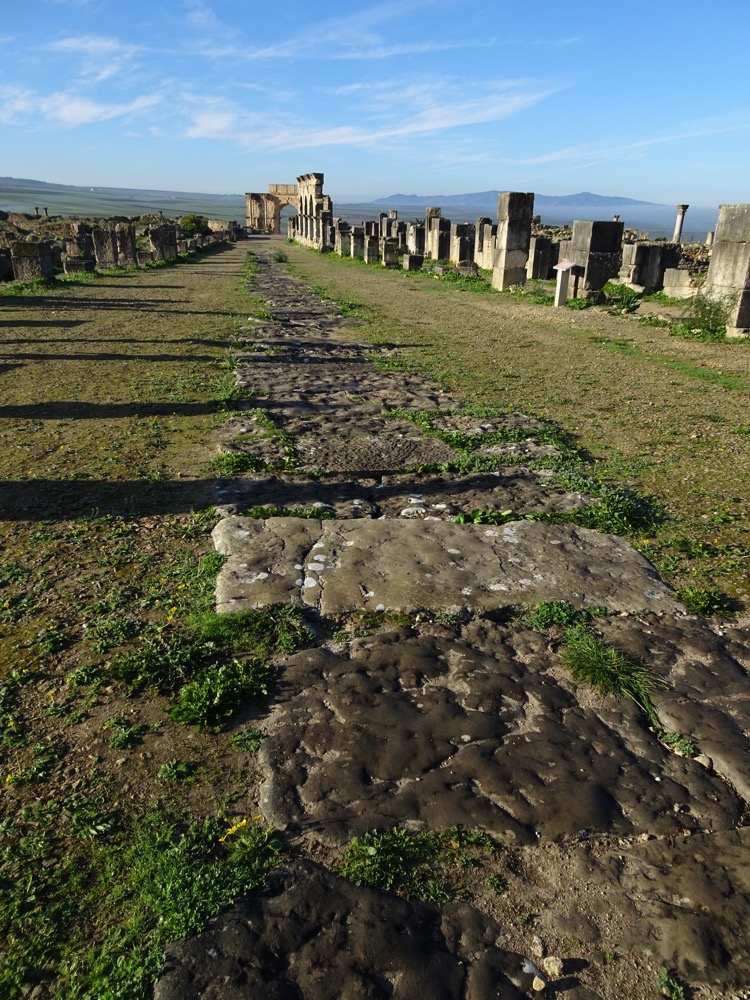
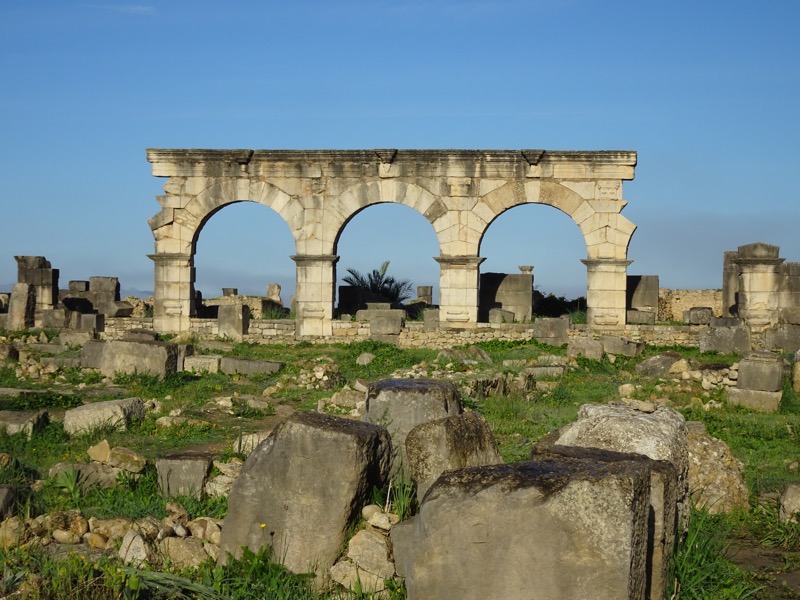 Attached to the site is a relatively new interpretive centre with some artefacts that were found on the site. Unfortunately, much of the site’s treasures have landed in the various museums of Europe, but there were some interesting objects housed here, including these steles from the Mauritanian to the Roman period. A stele was a small monument which depicts a character in relief or engraved often showing offerings in their hands.
Attached to the site is a relatively new interpretive centre with some artefacts that were found on the site. Unfortunately, much of the site’s treasures have landed in the various museums of Europe, but there were some interesting objects housed here, including these steles from the Mauritanian to the Roman period. A stele was a small monument which depicts a character in relief or engraved often showing offerings in their hands. 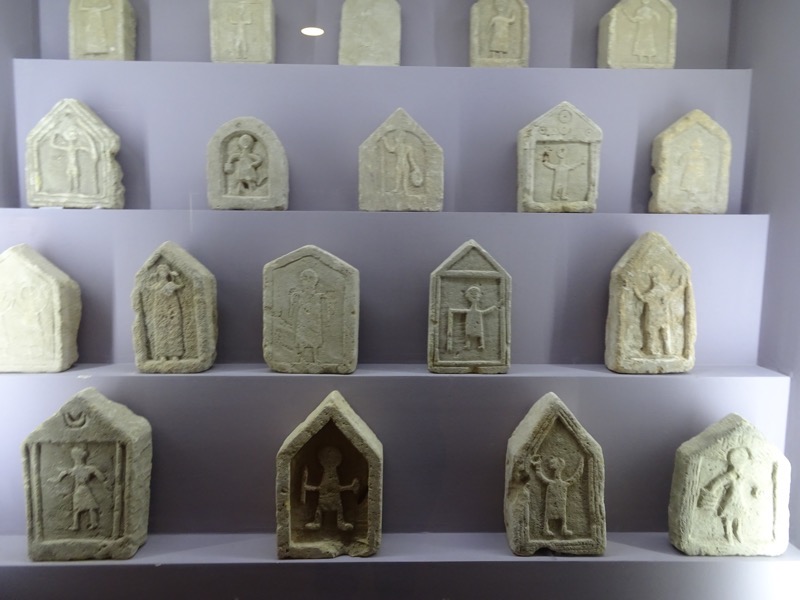
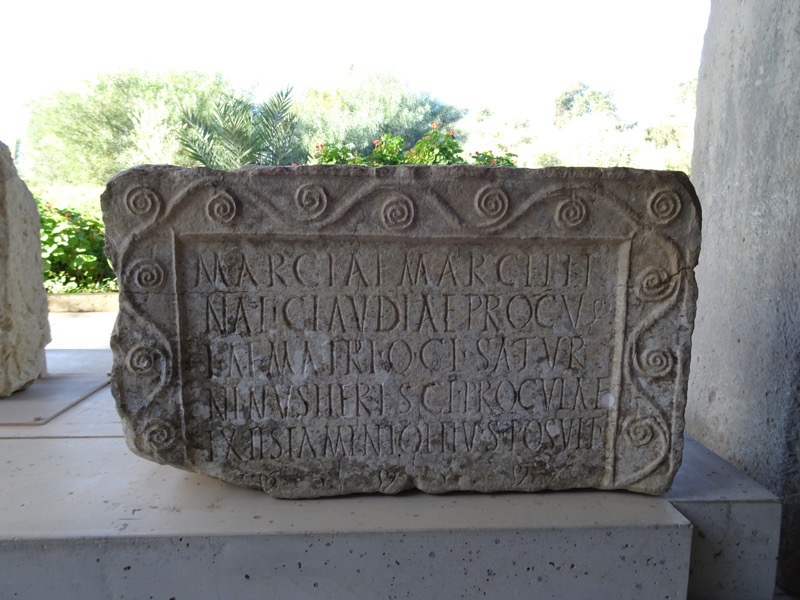
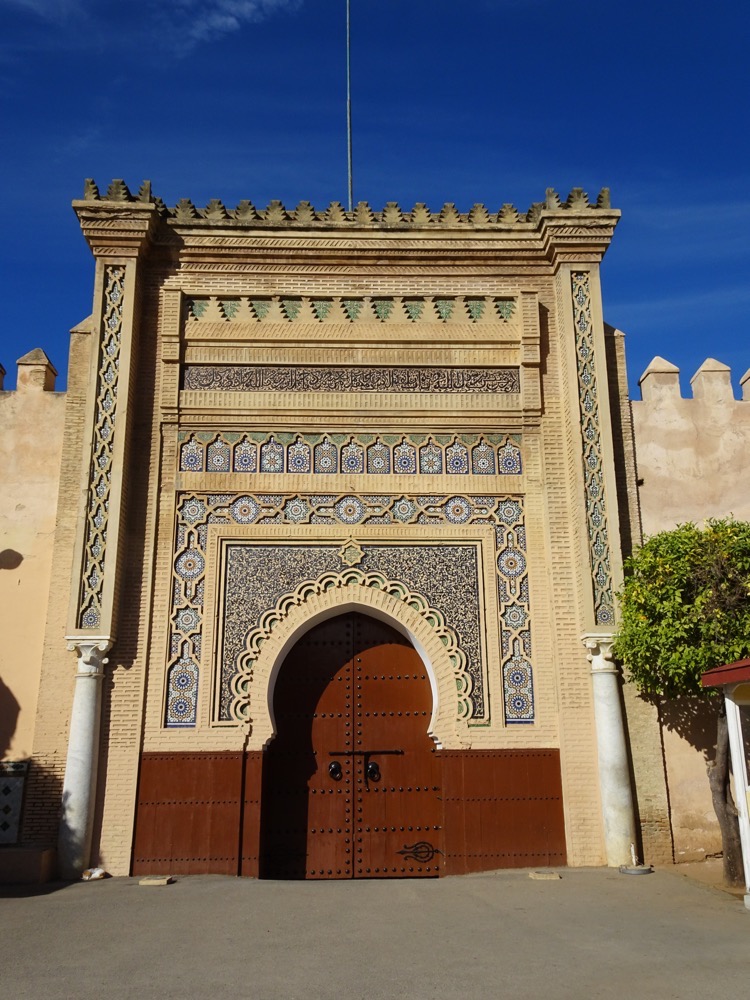 The Royal Palace still belongs to the current royal family and is not open to visitors. Inside we believe there are lavish buildings and a golf course for the King and his visitors.
The Royal Palace still belongs to the current royal family and is not open to visitors. Inside we believe there are lavish buildings and a golf course for the King and his visitors.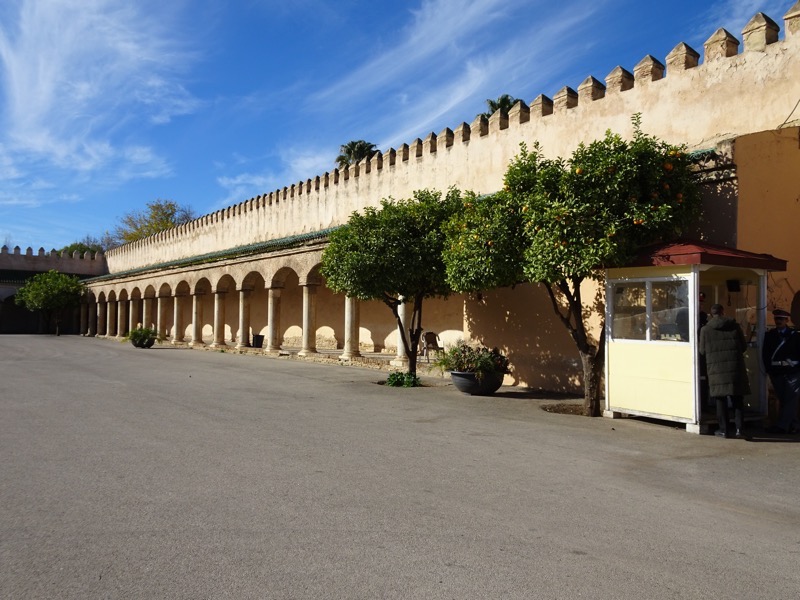 Outside, rows of palms and Seville orange trees…
Outside, rows of palms and Seville orange trees…

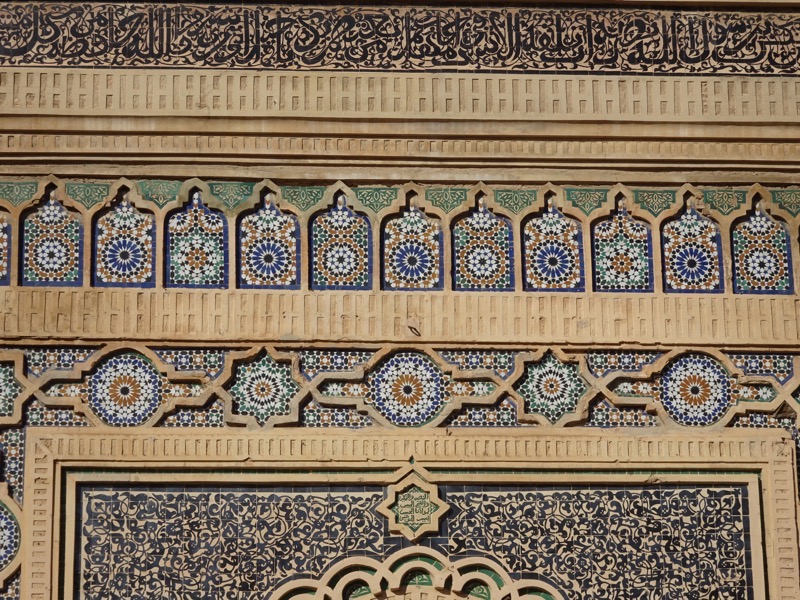 A modern monument celebrating the water bearers who wear the funny outfits.
A modern monument celebrating the water bearers who wear the funny outfits.
 The Sahrij Swani – enormous granaries and stables that were built to support the military – the stables used to house some 3000 horses at the height of the Alaouite dynasty.
The Sahrij Swani – enormous granaries and stables that were built to support the military – the stables used to house some 3000 horses at the height of the Alaouite dynasty. The Bab El Khemis Gate Built in 1693, near the Riad and Mellah quarters – we saw a heavily overloaded truck speed through this gate. It barely scraped through, we all did a sharp intake of breath as it screamed towards it. Whoever packed up that truck was obviously very familiar with the size of the gate!
The Bab El Khemis Gate Built in 1693, near the Riad and Mellah quarters – we saw a heavily overloaded truck speed through this gate. It barely scraped through, we all did a sharp intake of breath as it screamed towards it. Whoever packed up that truck was obviously very familiar with the size of the gate! 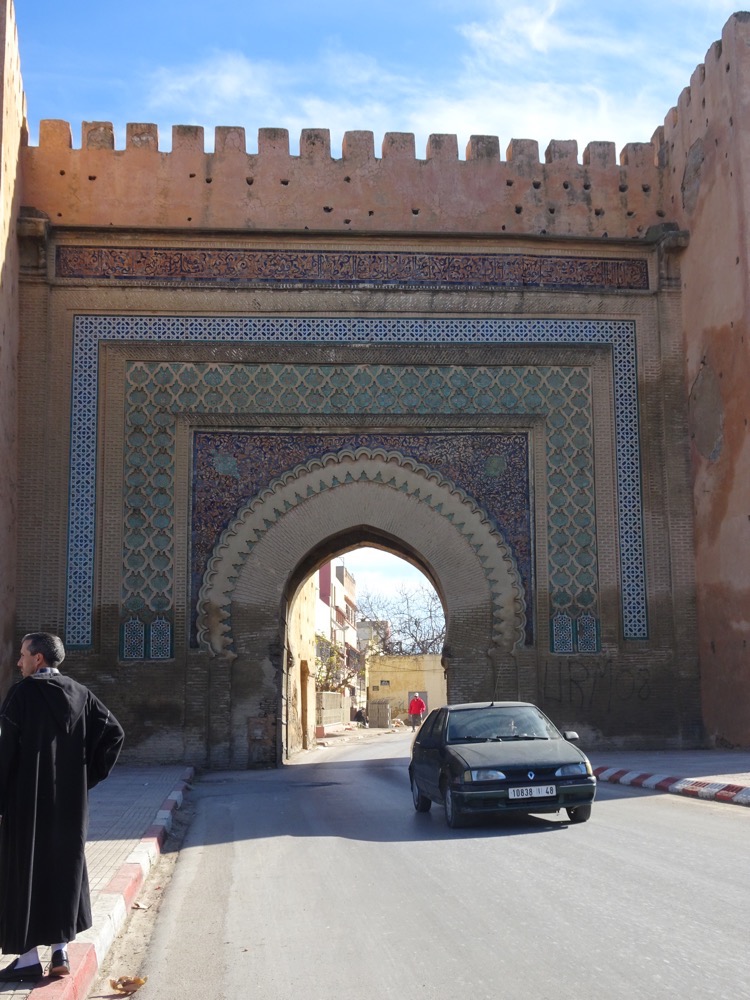 The very famous Bab El-Mansour gate, covered in mosaics, tile work and koranic inscriptions – built in 1732.
The very famous Bab El-Mansour gate, covered in mosaics, tile work and koranic inscriptions – built in 1732.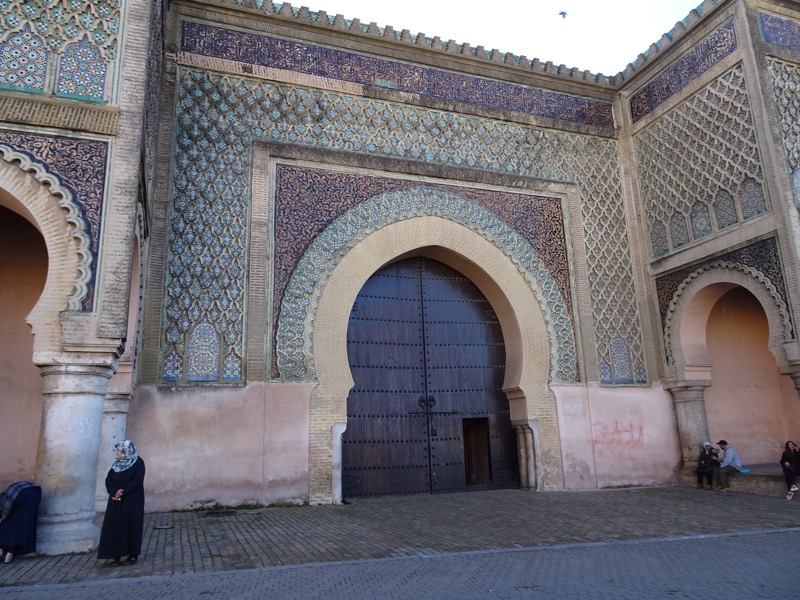 The history of the gate tells us that on completion of the gate when the Sultan inspected it, he asked the architect El-Mansour if he could do better, El-Mansour felt compelled to say ‘yes’, probably anticipating another commission. Instead, the Sultan was infuriated and had El-Mansour immediately executed.
The history of the gate tells us that on completion of the gate when the Sultan inspected it, he asked the architect El-Mansour if he could do better, El-Mansour felt compelled to say ‘yes’, probably anticipating another commission. Instead, the Sultan was infuriated and had El-Mansour immediately executed.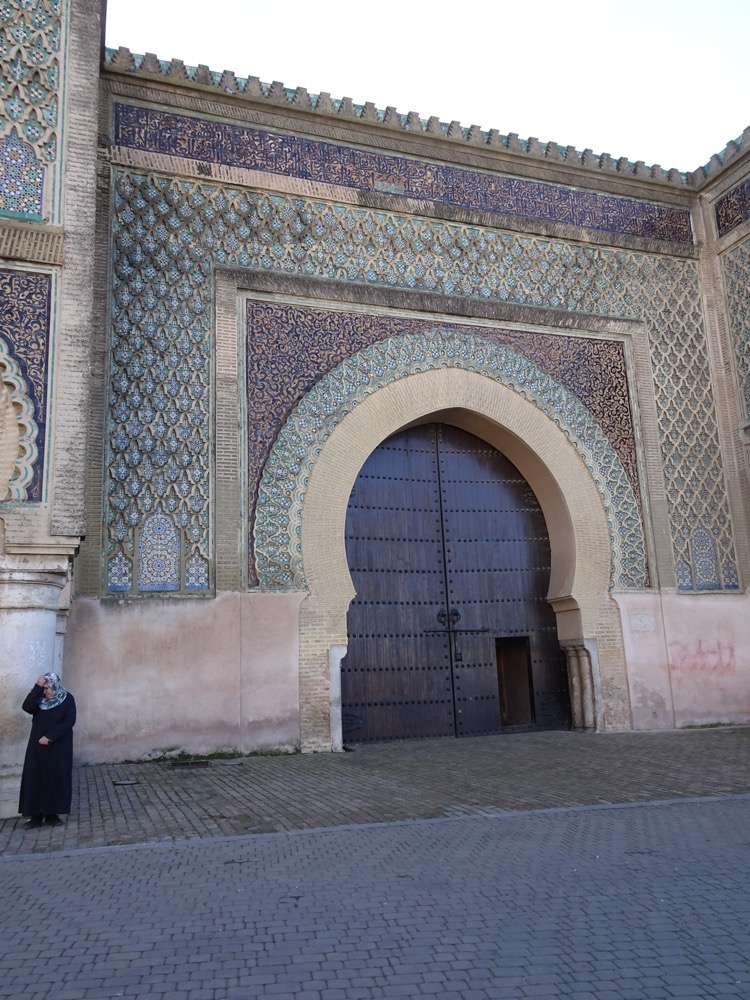
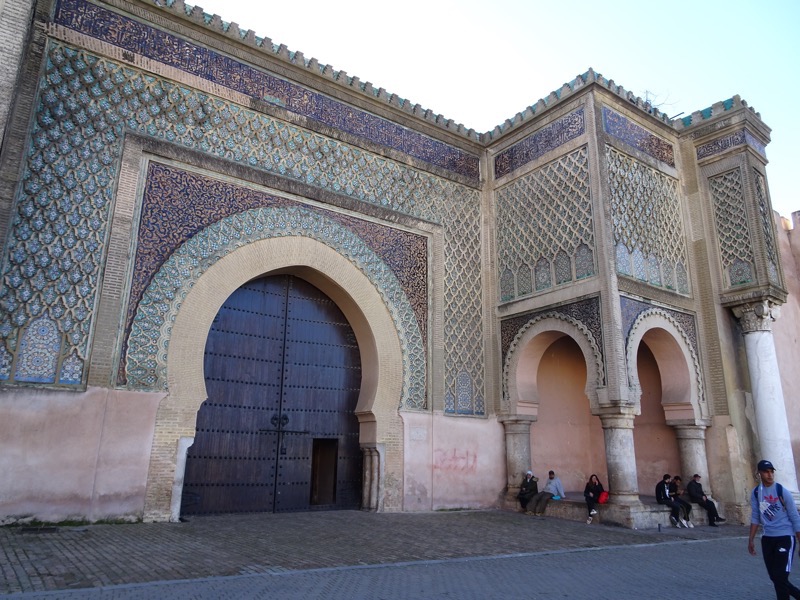
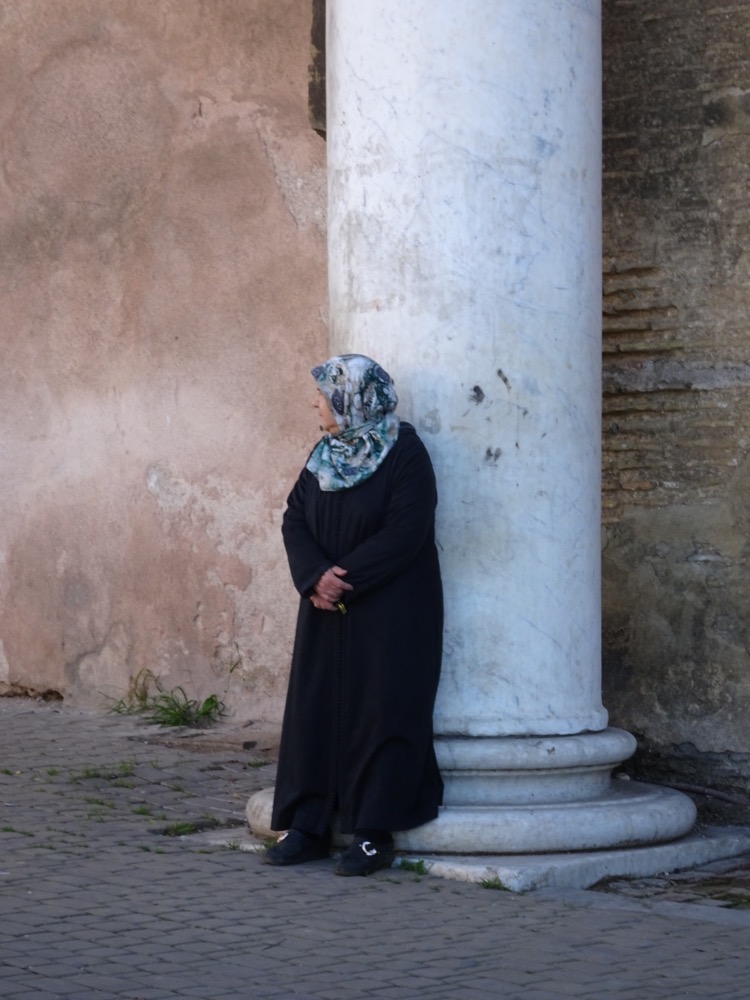 While I love the weird integration of Islamic and Roman elements in the design – it was less than impressive to learn that the columns were pilfered from Volubilis.
While I love the weird integration of Islamic and Roman elements in the design – it was less than impressive to learn that the columns were pilfered from Volubilis.  Across the road from the gate is an enormous town square – currently occupied by snake charmers (yes, actual snake charmers, though I don’t think they were very good – their snakes were mostly just laying around in the sun), and men with little monkeys on chains dressed in soccer team shirts that they were literally throwing onto hapless tourists to take photos with, so they could then demand money from the unsuspecting visitors. Most of our group is very well travelled and didn’t fall for this nonsense. Poor little monkeys. 🙁
Across the road from the gate is an enormous town square – currently occupied by snake charmers (yes, actual snake charmers, though I don’t think they were very good – their snakes were mostly just laying around in the sun), and men with little monkeys on chains dressed in soccer team shirts that they were literally throwing onto hapless tourists to take photos with, so they could then demand money from the unsuspecting visitors. Most of our group is very well travelled and didn’t fall for this nonsense. Poor little monkeys. 🙁 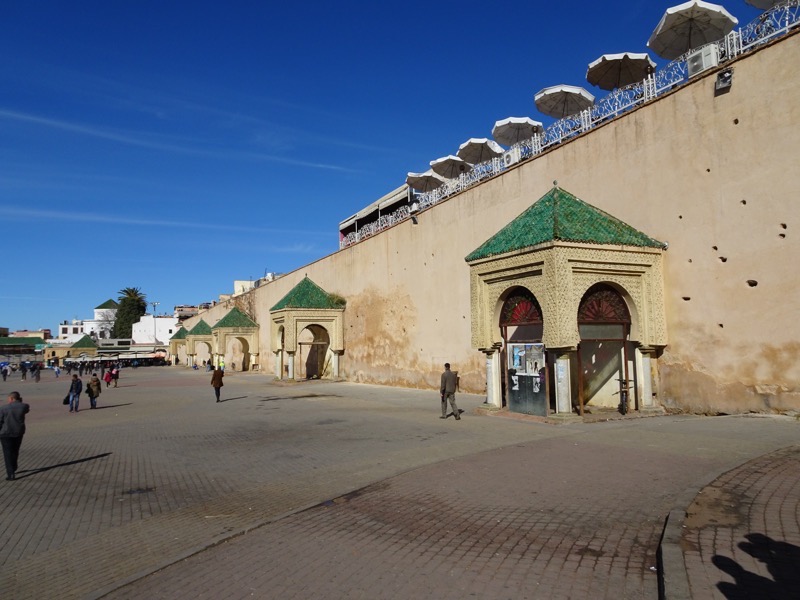 Surrounding the square was an endless row of restaurants and people selling tiles and ceramics and all sorts. The green-roofed doorway to right of this picture was the entrance to the undercover food market, which was full of shops selling spices, dates, figs, olives, pickles and down the smelly end – unrefrigerated meat.
Surrounding the square was an endless row of restaurants and people selling tiles and ceramics and all sorts. The green-roofed doorway to right of this picture was the entrance to the undercover food market, which was full of shops selling spices, dates, figs, olives, pickles and down the smelly end – unrefrigerated meat.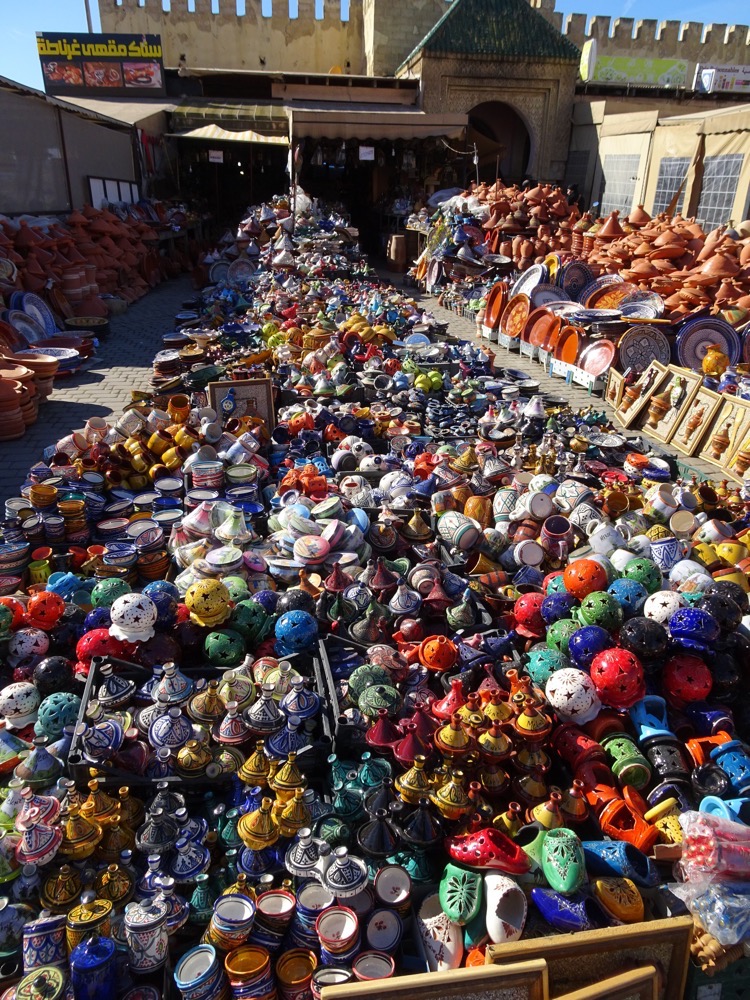
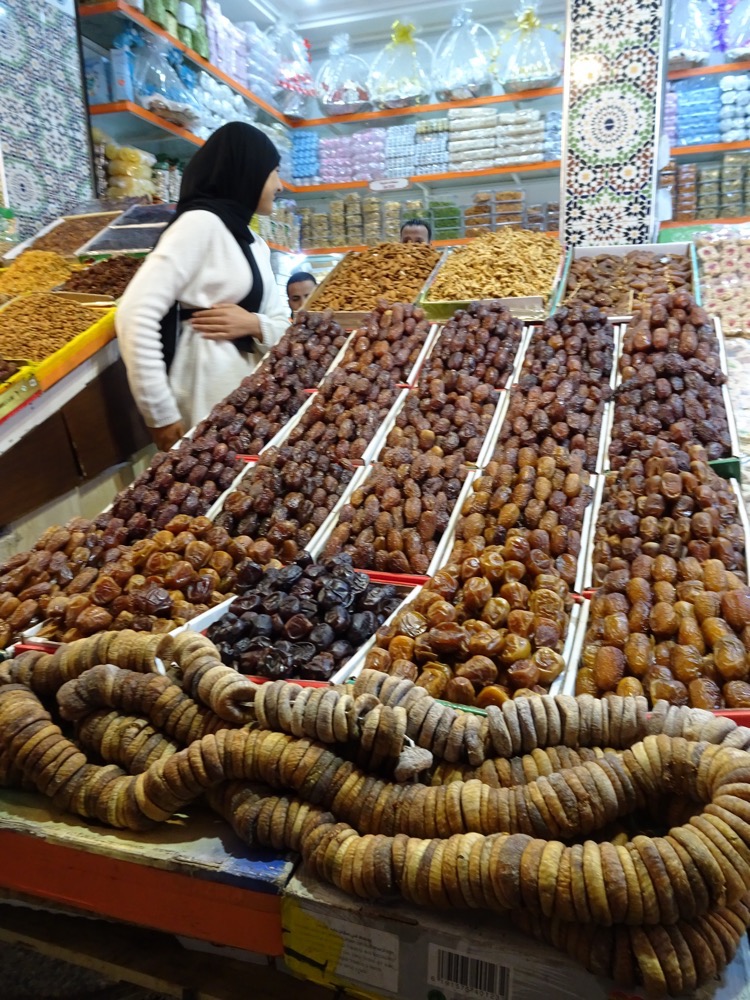 Olives, olives and more olives.
Olives, olives and more olives. Across the other side of the square, away from the food markets was a maze of little alleyways that were more focused on the textile industries – stores full of silk, braids, garments, and garish fabric. You could hear the busy clatter of old embroidery machines around every corner.
Across the other side of the square, away from the food markets was a maze of little alleyways that were more focused on the textile industries – stores full of silk, braids, garments, and garish fabric. You could hear the busy clatter of old embroidery machines around every corner. 


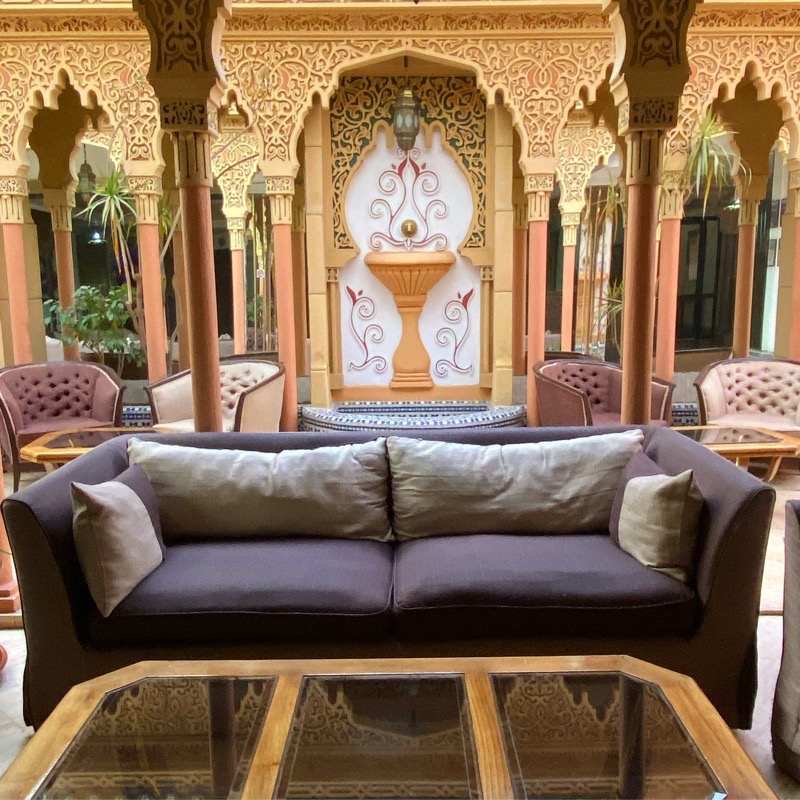
 All up, a very tasty meal with some unsual offerings, which, including drinks and tips, it came to a grand total of 55DH per person compared to the 120DH per person at the first tourist restaurant… but someone else can have the next conversation with Samirr when the group wants to change the plan!
All up, a very tasty meal with some unsual offerings, which, including drinks and tips, it came to a grand total of 55DH per person compared to the 120DH per person at the first tourist restaurant… but someone else can have the next conversation with Samirr when the group wants to change the plan! !
!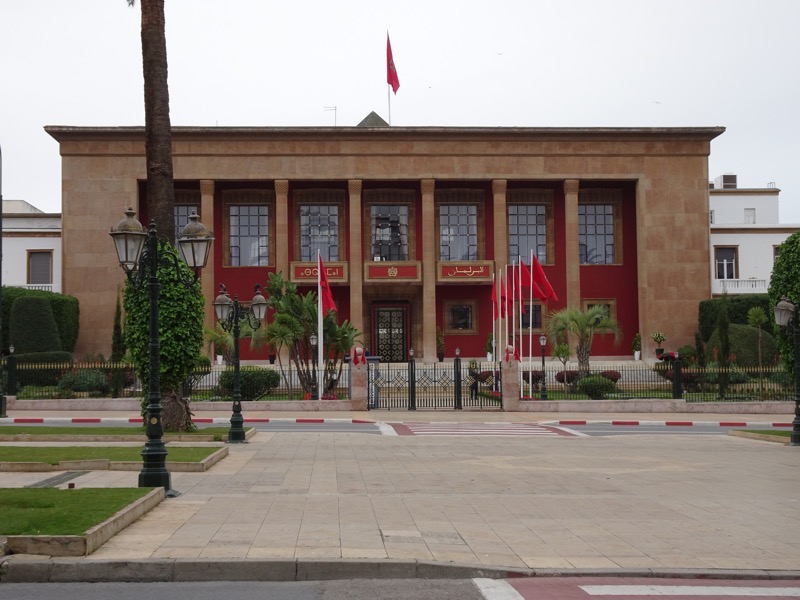
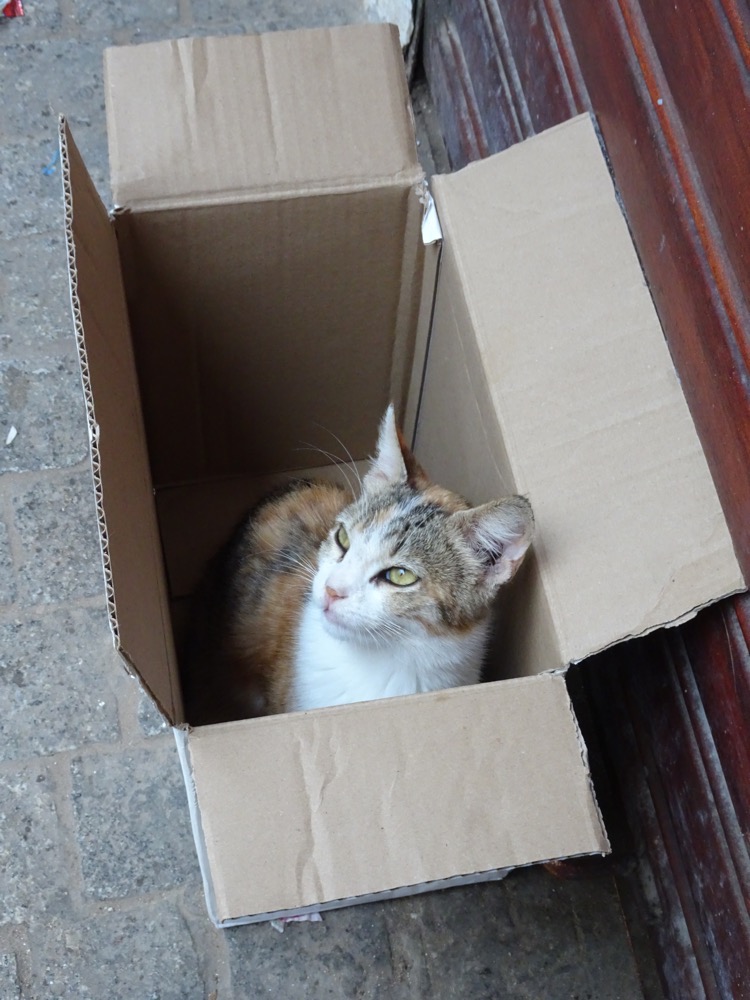
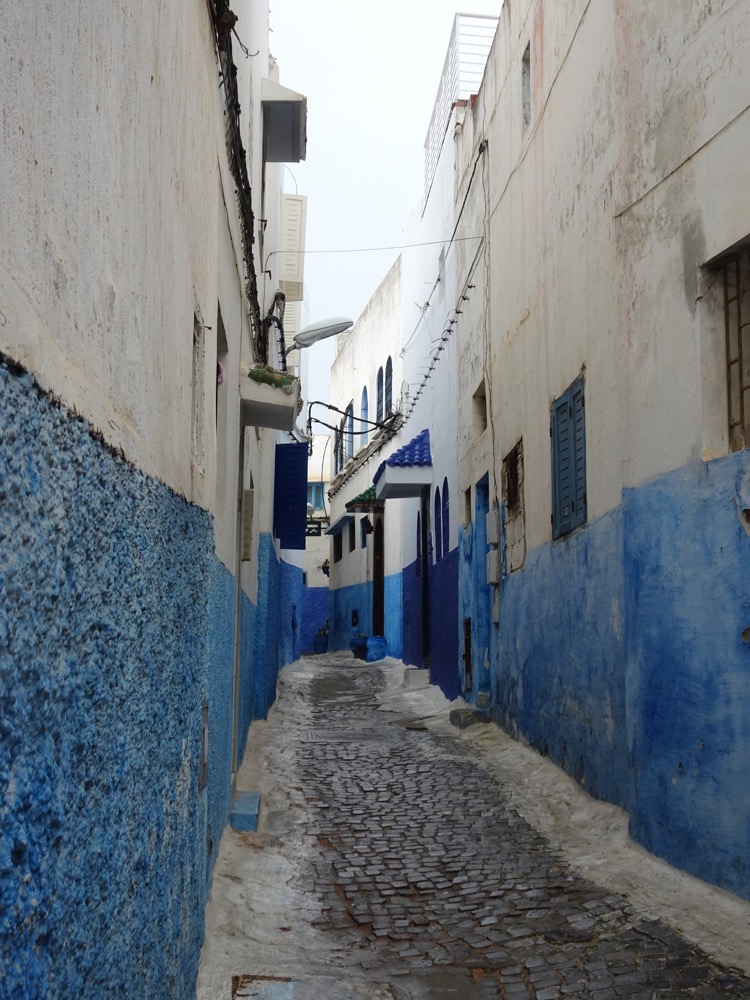
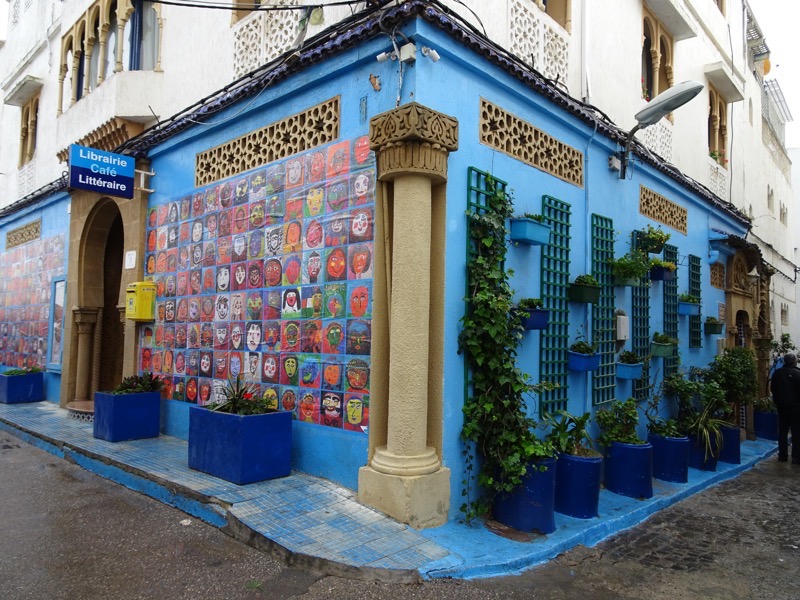
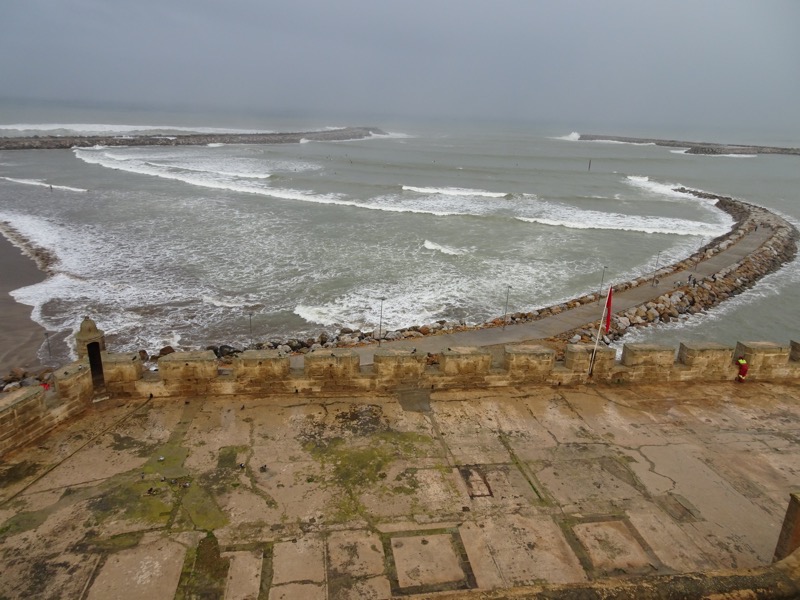
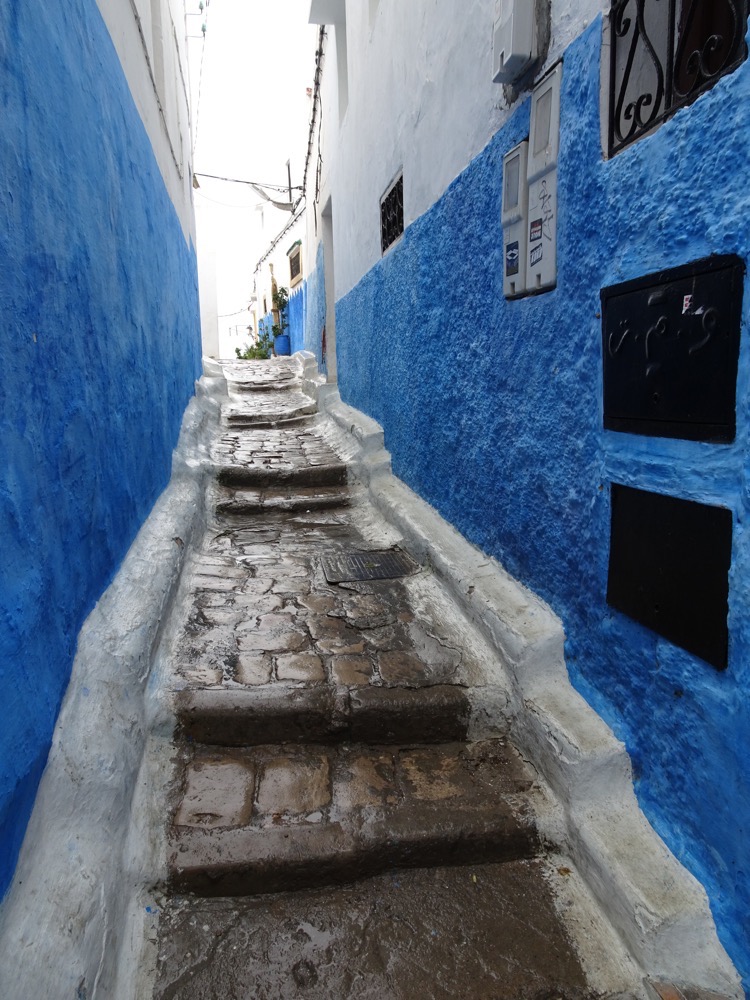


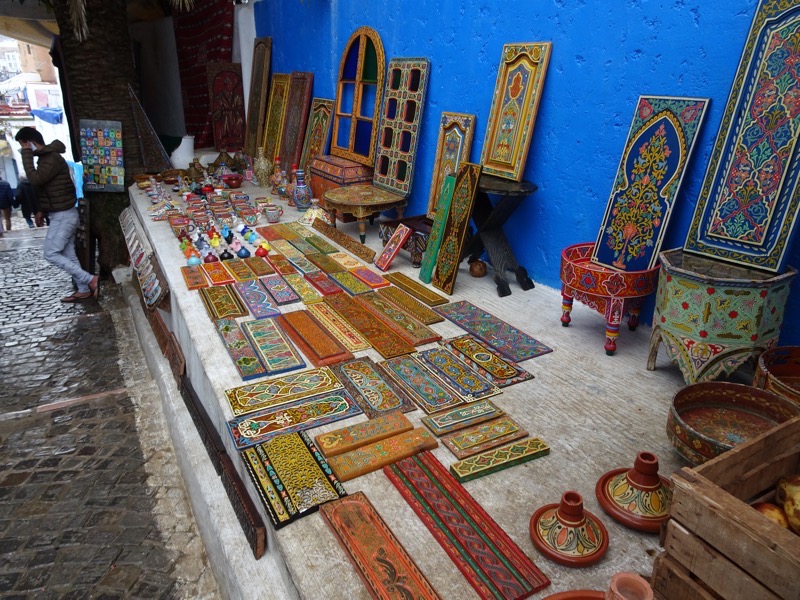
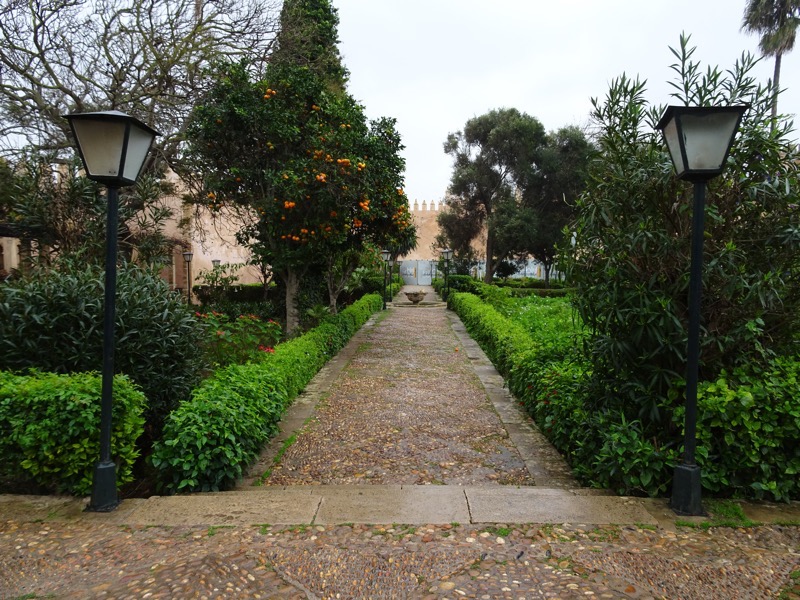 t was a very cute part of Rabat to go wandering through – it has approximately 3000 residents currently, and possibly about 500 cats judging by what we saw today. They’re everywhere, and all very well fed and happy looking critters.
t was a very cute part of Rabat to go wandering through – it has approximately 3000 residents currently, and possibly about 500 cats judging by what we saw today. They’re everywhere, and all very well fed and happy looking critters.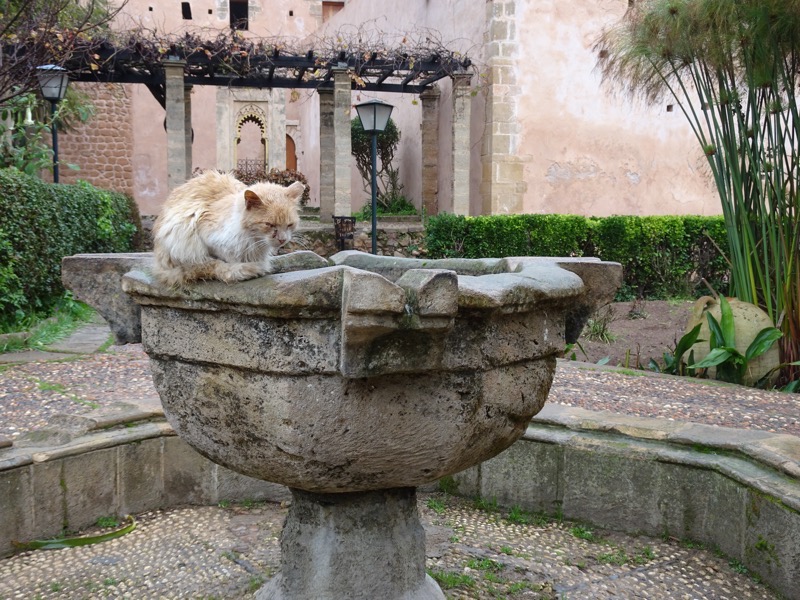 Andalusian Gardens
Andalusian Gardens
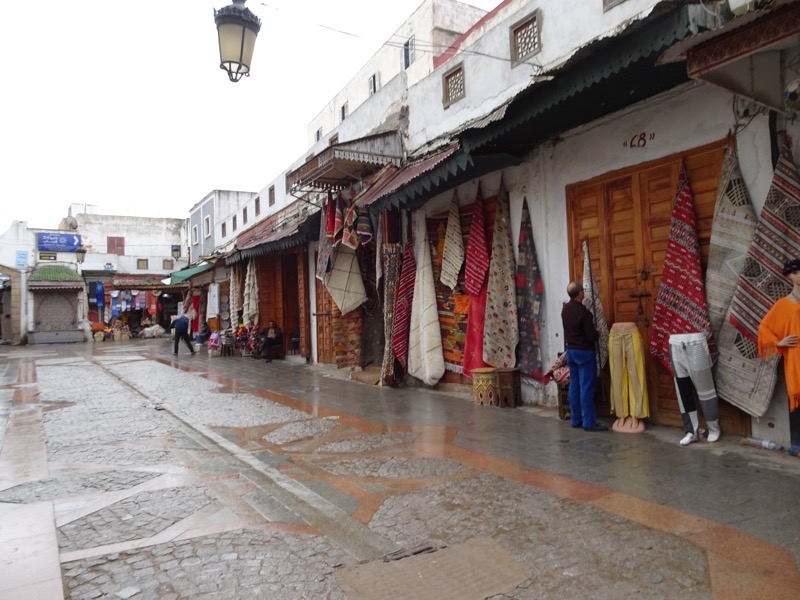

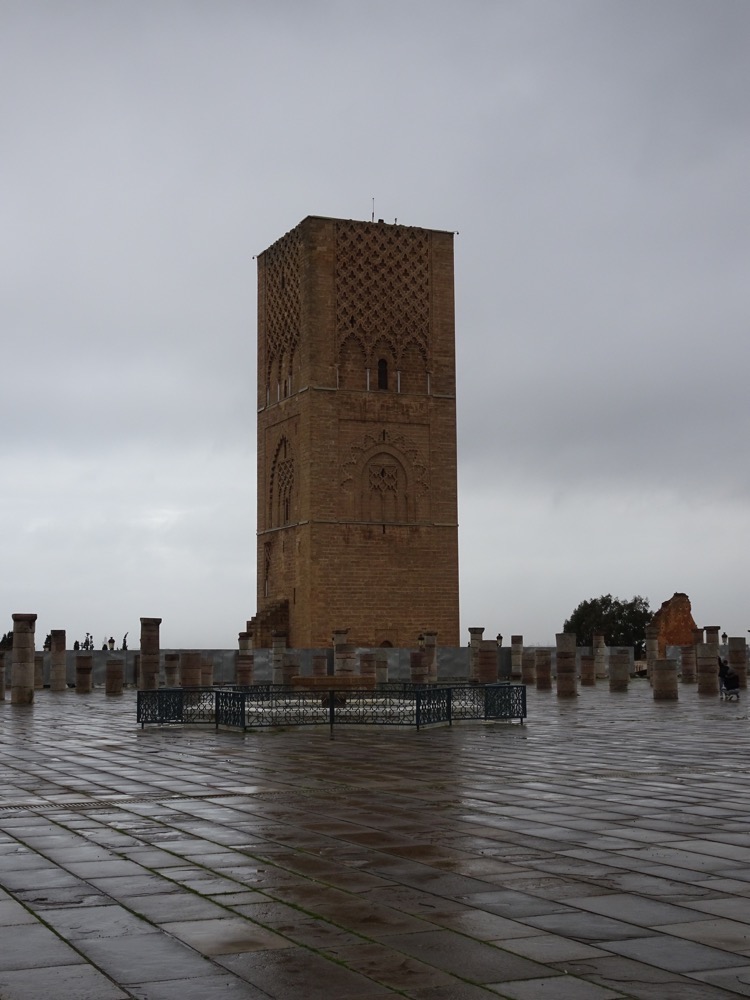
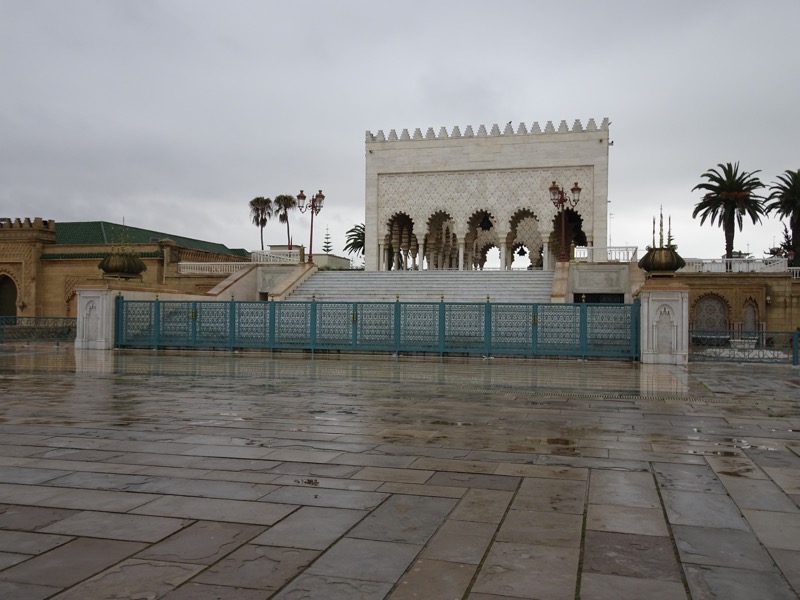

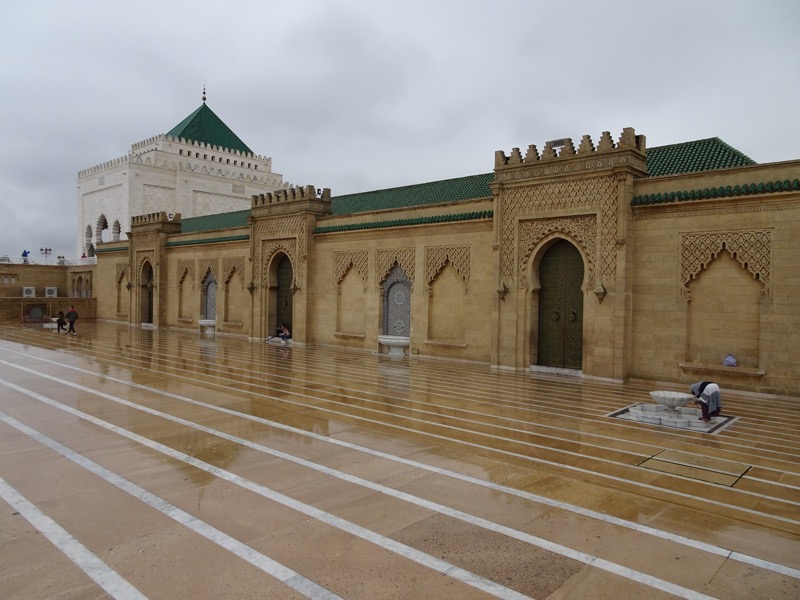 By this point of our day, I was getting a little WTF? As mentioned earlier, our dodgy tourist map hadn’t really laid out for us how far apart things were, and I had inadvertently been walking about 9kms on shitty uneven cobblestones for nearly three hours and my hips and lower back were getting decidedly unhappy with me. So we decided to take a local tram to find St Peter’s Cathedral which is located at Golan Square right in downtown Rabat. It was only built in 1919 and is in a rather bland Art Deco style… I know – I am decidedly hard to impress when it comes to churches and architecture, and this one left very little impression on me. It was designed by someone called Adrien Laforgue… and quite frankly Adrien, I feel you let us all down. When you have the sort of dish that the Catholic Church is prepared to throw at a thing like a new cathedral, you really should have been able to come up with something a bit more … well, just a bit more?!
By this point of our day, I was getting a little WTF? As mentioned earlier, our dodgy tourist map hadn’t really laid out for us how far apart things were, and I had inadvertently been walking about 9kms on shitty uneven cobblestones for nearly three hours and my hips and lower back were getting decidedly unhappy with me. So we decided to take a local tram to find St Peter’s Cathedral which is located at Golan Square right in downtown Rabat. It was only built in 1919 and is in a rather bland Art Deco style… I know – I am decidedly hard to impress when it comes to churches and architecture, and this one left very little impression on me. It was designed by someone called Adrien Laforgue… and quite frankly Adrien, I feel you let us all down. When you have the sort of dish that the Catholic Church is prepared to throw at a thing like a new cathedral, you really should have been able to come up with something a bit more … well, just a bit more?!





 Once we were here, I had to pull the pin on going for a walk around the town to see the buildings, the bakery, the mosque etc… instead Mr K took a pile of photos of me – primarily of the town at sunset – so that I wouldn’t get the total FOMOs. I had to kick off my shoes and rest my lower back, which totally sucks! Thankfully this seem to be one of the longest and most intense days on our itinerary, so it should get a bit easier from here.
Once we were here, I had to pull the pin on going for a walk around the town to see the buildings, the bakery, the mosque etc… instead Mr K took a pile of photos of me – primarily of the town at sunset – so that I wouldn’t get the total FOMOs. I had to kick off my shoes and rest my lower back, which totally sucks! Thankfully this seem to be one of the longest and most intense days on our itinerary, so it should get a bit easier from here.